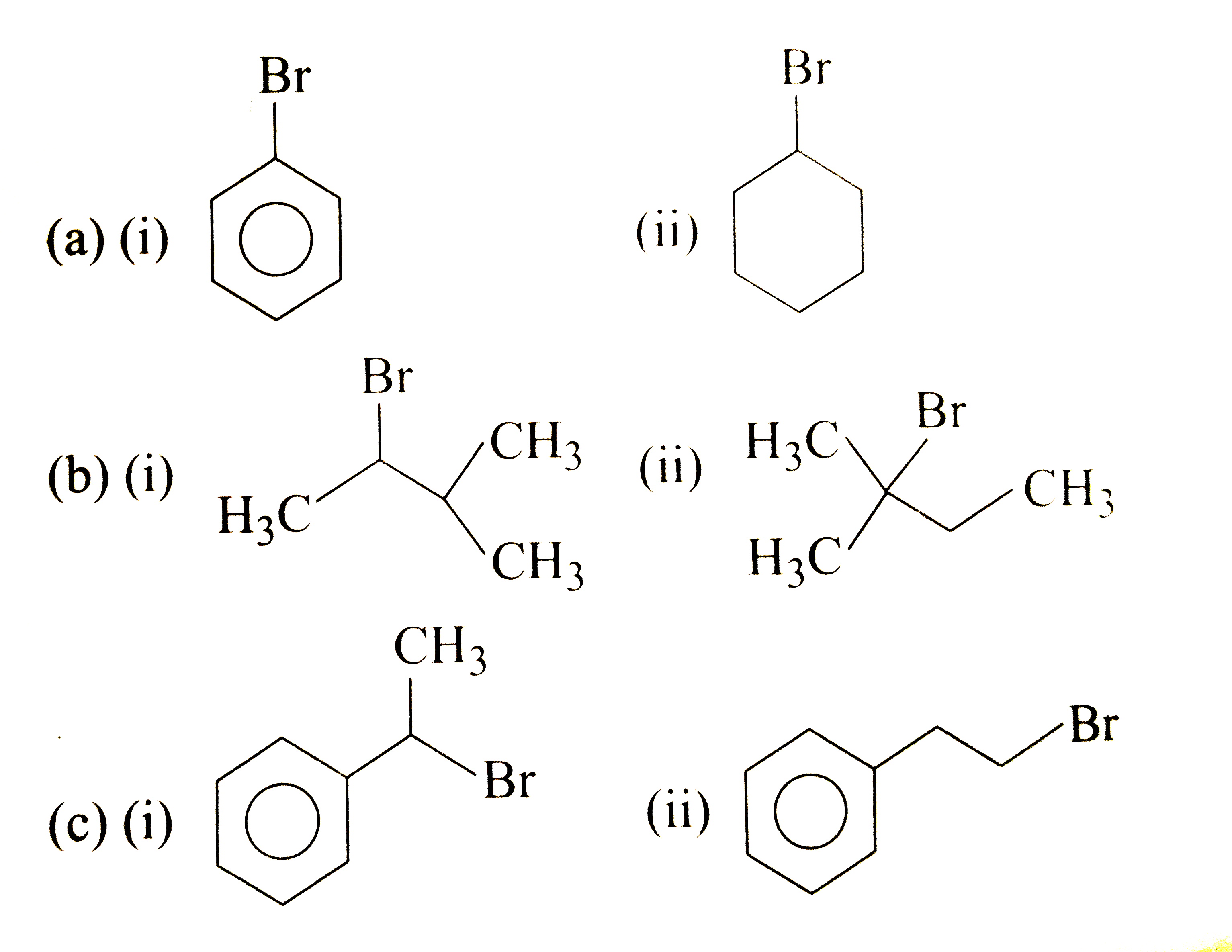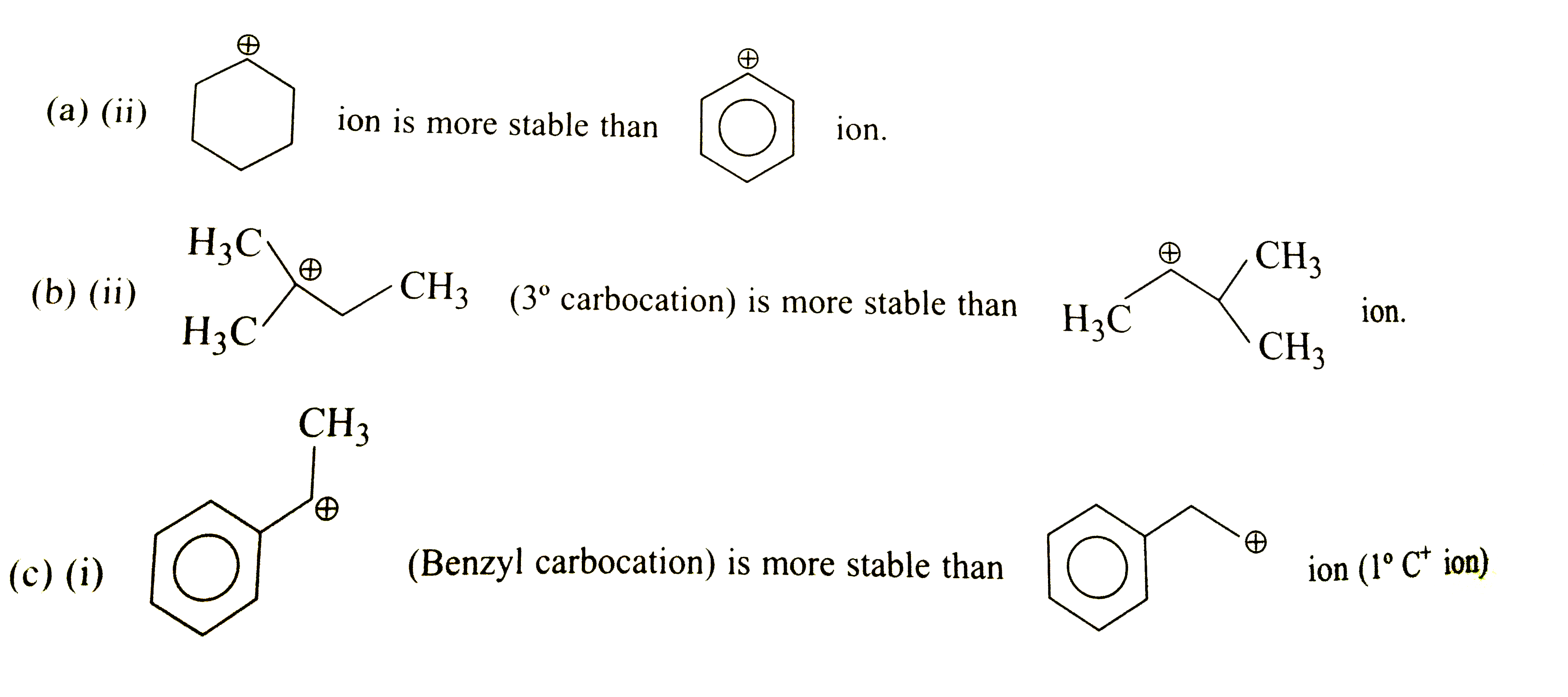REACTION MECHANISM for Class 11 CHEMISTRY
INTRODUCTION
A chemical equation is a symbolic representation of a chemical change. It indicates the initial reactants and final products involved in a chemical change. Reactants generally consist of two species; One which is being attacked; it is called a substrate. Other which attacks the substrate; it is referred to as a reagent. These two interact to form products.
Most of the reactions are complex and take place via intermediates which may or may not be isolated. The intermediates are generally very reactive. They react readily with other species present in the environment to form the final products. The detailed step by step description of a chemical reaction is called its mechanism.
Elementary and Non-Elementary Reactions
An elementary reaction is a single step reaction with a single transition state and no intermediates. Elementary reactions add up to complex reactions; Non-Elementary Reactions can be described by multiple elementary reaction steps. A set of elementary reactions comprises a reaction mechanism, which predicts the elementary steps involved in a complex reaction. Below are two reaction coordinates of two reactions. One describes an elementary reaction, and the other describes a non-elementary reaction.

Elementary Reaction (One Step)
Note that there is one transition state and no intermediate. Elementary steps cannot be broken down into simpler reactions.
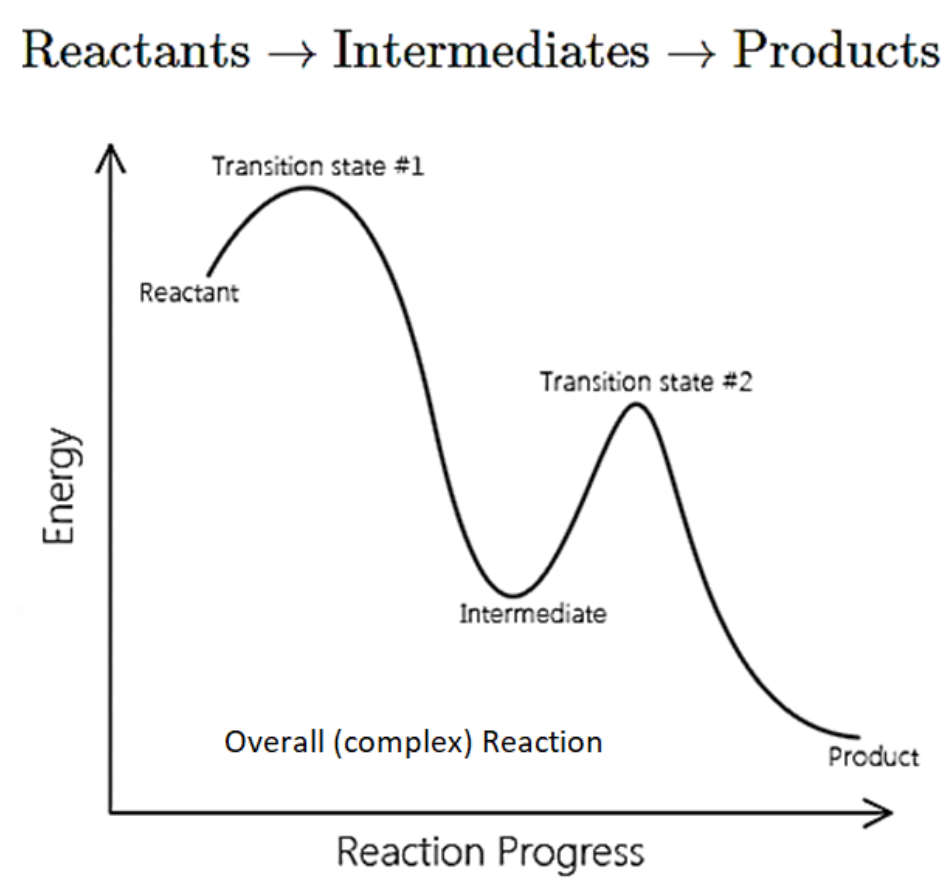
Two Step Reaction
This is a sample reaction coordinate of a complex reaction. Note that it involves an intermediate and multiple transition states. A complex reaction can be explained in terms of elementary reactions.
Exothermic and Endothermic Reactions
Chemical reactions ke sath mostly evolution ya absorption of energy accompany hoti hai. Evolution ya absorption of energy ke basis par ye 2 type meh classified hai : exothermic and endothermic reactions.
1. Exothermic Reactions
Jo chemical reactions evolution of heat energy se proceed karte hai unhe exothermic reactions kaha jata hai. Jo heat energy produce hoti hai during the reactions usse +q se indicate kara jata hai ya more precisely products side par uski actual numerical value likhi jati hai. In general, exothermic reactions ko hum represent kar sakte hai as :
Ab humne ye padha hai that jo heat evolve hoti hai at constant pressure and constant temperature, wo enthalpy change (ΔH) ke equal hoti hai. Exothermic reactions meh, products ki enthalpy less hoti hai than the enthalpy of the reactants jis wajah se enthalpy change jo total enthalpy of products minus total enthalpy of reactants hoti hai wo negative ho jati hai as shown below :
Hp<Hr
∴ΔH=−ve
2. Endothermic Reactions
Jo chemical reactions absorption of heat energy se proceed karte hai unhe endothermic reactions kaha jata hai. Since inn reactions meh heat add hoti hai to the reactants, toh heat absorbed ko +q se indicate kara jata hai ya fir actual numerical value of heat ko reactants side par likha jata hai.
Alternatively, it may be written as :
Jo heat absorb hoti hai constant temperature aur constant pressure par usse hum enthalpy change ko measure kar sakte hai. Absorption of heat ki wajah se, products ki enthalpy more hoti hai than the enthalpy of the reactants. Consequently, ΔH positive (+ve) hota hai for endothermic reactions.
Hp>Hr
∴ΔH=+ve
Exothermic aur endothermic reations ke liye enthalpy change below figure meh shown hai.
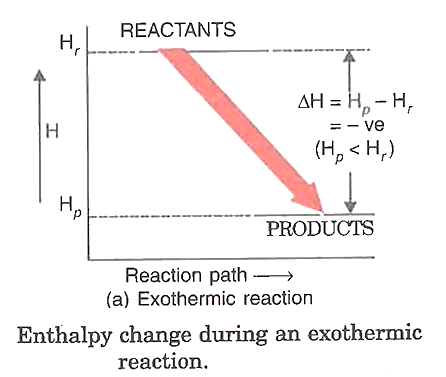
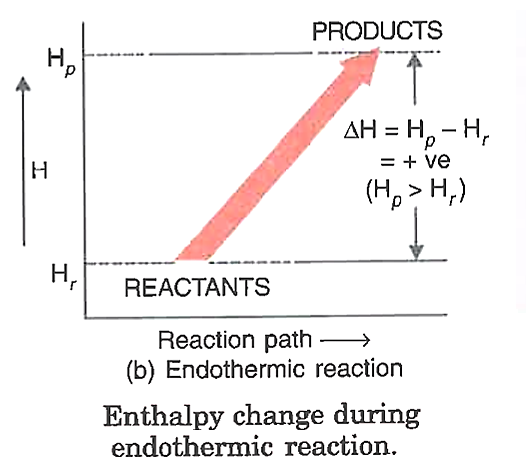
Thus, ab hum ye conclude kar sakte hai that
Endothermic reactions ke liye, ΔH=+ve
Exothermic and Endothermic Reactions
The chemical reactions are often accompanied by evolution or absorption of energy. Depending upon the evolution or absorption of energy they are classified into two types : exothermic and endothermic reactions.
1. Exothermic Reactions
The chemical reactions which proceed with the evolution of heat energy are called exothermic reactions. The heat energy produced during the reactions is indicated by writing +q or more precisely by giving the actual numerical value on the products side. In general, exothermic reactions may be represented as:
We have already learnt that the heat evolved at constant pressure and constant temperature is equal to the enthalpy change (ΔH). In the exothermic reactions, the enthalpy of the products will be less than the enthalpy of the reactants so that the enthalpy change which is the total enthalpy of products minus the total enthalpy of reactants is negative as shown below :
Hp<Hr
∴ΔH=−ve
2. Endothermic Reactions
The chemical reactions which proceed with the absorption of heat energy are called endothermic reactions. Since the heat is added to the reactants in these reactions, the heat absorbed is indicated by either putting +q or by writing the actual numerical value of heat on the reactants side.
Alternatively, it may be written as :
The heat absorbed at constant temperature and constant pressure measures enthalpy change. Because of the absorption of heat, the enthalpy of the products will be more than the enthalpy of the reactants. Consequently, ΔH will be positive (+ve) for the endothermic reactions.
Hp>Hr
∴ΔH=+ve
The enthalpy change for exothermic reaction and endothermic reations are shown in figure below.


Thus, it may be concluded that
For endothermic reactions, ΔH=+ve
Carbocations (Carbonium ions)
When a covalent bond, in which carbon is linked to a more electronegative atom or group, breaks up by heterolytic fission, the more electronegative atom takes away the electron pair while carbon loses its electron and thus acquires a positive charge. Such organic ions carrying a positive charge on carbon atom are known as carbocations or carbonium ions.

Carbocations are named by adding the words carbocation to the parent alkyl group. These are also termed as primary, secondary, tertiary, depending upon the nature of the carbon atom bearing positive charge.
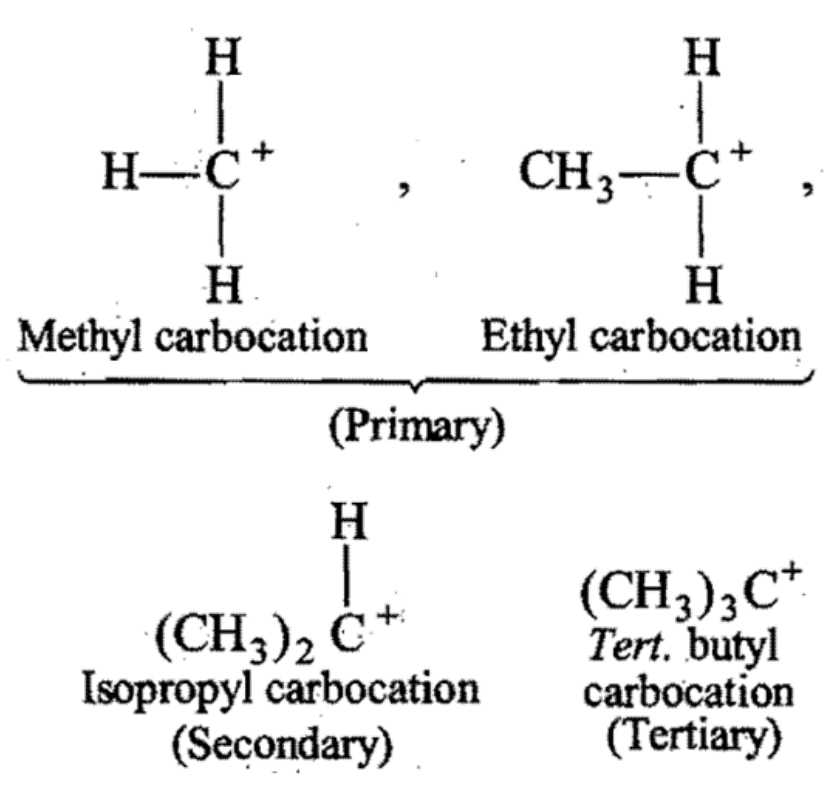
Formation of Carbocations
(a) By Heterolysis : They are formed by heterolysis of halogen compounds.

(b) By Protonation of Alkenes or Alcohols :

(c) By Decomposition of Diazo Compounds :

Characteristics of Carbocation
(a) Carbon atom carrying positive charge has six electrons in its valence shell, i.e., 2 electrons less than octet.
(b) The positively charged carbon atom in the carbocation is in sp2 state of hybridization (trigonal planar). The three hybridized orbitals which lie in the same plane are involved in the formation of three σ- bonds with other atoms or groups while the unhybridized p-orbital remains vacant. The carbocation has a planar structure.
Reactions Involving Carbocations
(i) Elimination reactions (E) to form alkenes from alkyl halides and alcohols.
(ii) Electrophilic addition reaction of alkenes, alkynes and alkadienes.
(iii) SN1 reactions of alkyl halides and diazonium salts.
(iv) Molecular pinacol-pinacolone rearrangement.
Structure of Carbocations
The only difference from free radicals which have odd electrons, carbocations are very reactive as they have a carbon atom having a vacant p-orbital (6 electrons in valence shell). The positively charged carbon atom tries to complete its octet and hence, these ions react readily with those species which can release two electrons for the formation of fourth bond, i.e., they react with nucleophilic reagents. Usually the order of reactivity of any chemical species is reverse to that of its stability. Therefore, the order of reactivity of ions is :
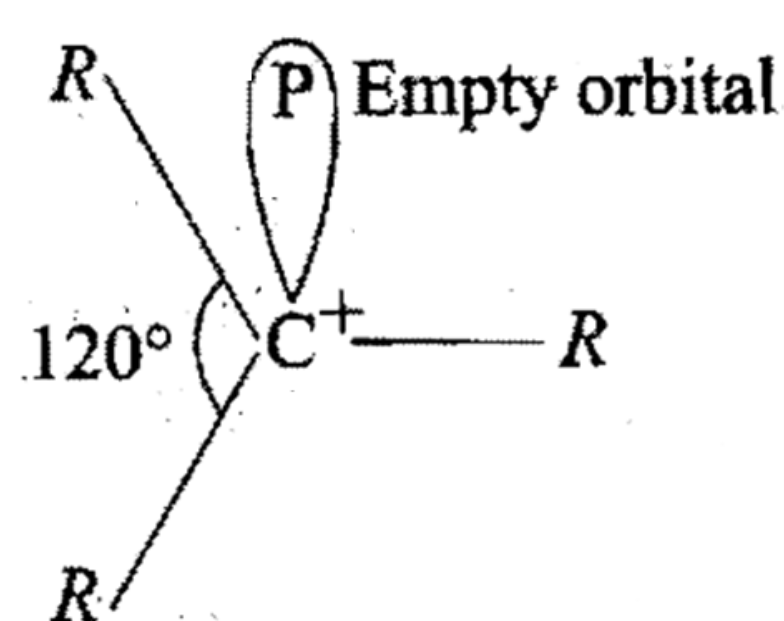
Stability
The stability of alkyl carbocations is influenced by resonance, hyperconjugation and inductive effects. An alkyl group has an electron releasing inductive effect. An alkyl group attached to the positively charged carbon of a carbocation tends to release electrons towards that carbon. In doing so it reduces positive charge on the carbon. In other words the positive charge gets dispersed as the alkyl group becomes somewhat positively charged itself. This dispersal of the charge stabilizes the carbocation. More the number of alkyl groups, the greater the dispersal of positive charge and, therefore, more the stability of carbocation is observed.
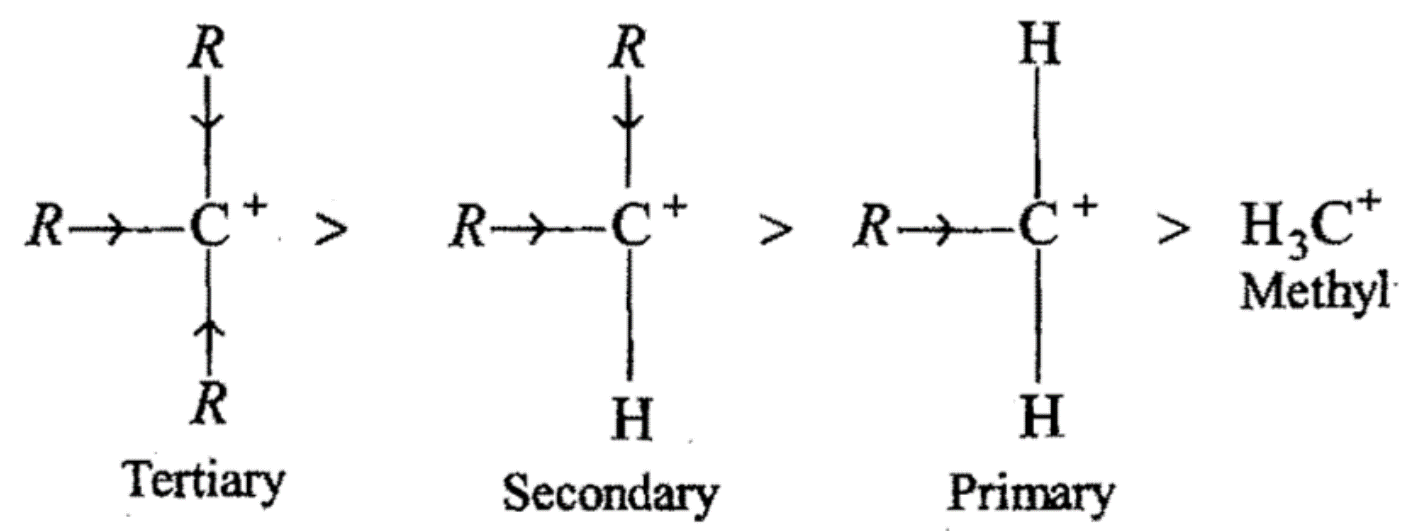
Stability decreases as +I decreases (dispersal of positive charge decreases).

Stability decreases as molecular mass decreases or +I effect decreases. If α-hydrogen with respect to carbocationic carbon has one or more than one lone pair of electrons, then lone pair of electrons strongly stabilises a carbocation due to the delocalization.
Amino (-NH2) and alkoxy (-OR) groups are important substituents for such type of carbocations.

Allyl and benzyl carbocations are much more stable as these are stabilized by resonance, while propylium (CH3CH2CH+2) ion has no resonance.
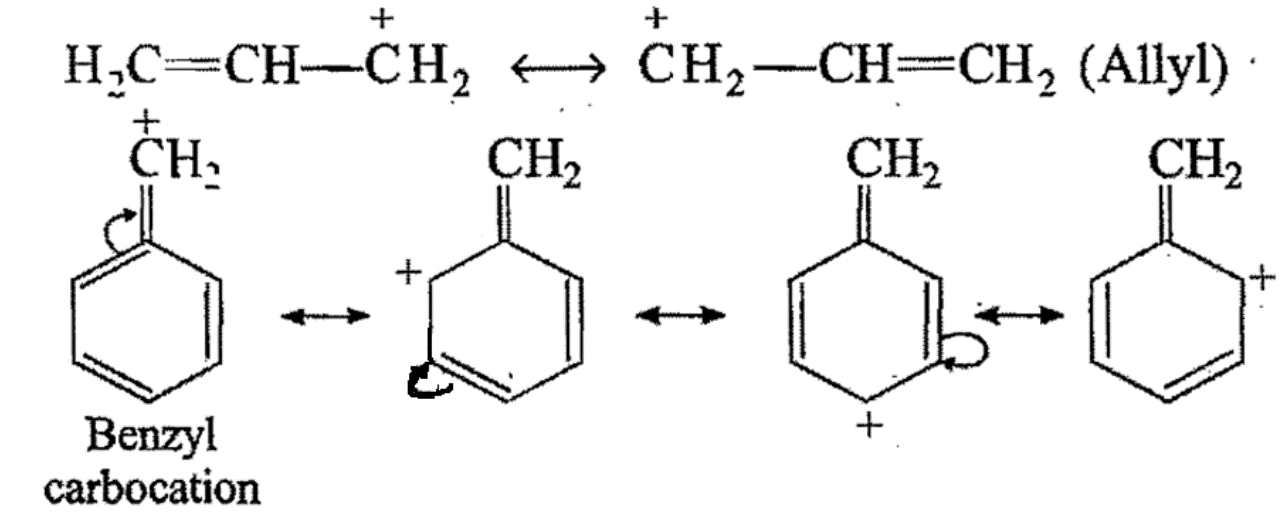
Allyl and benzyl carbocations are conjugated species, hence their stability can be compared by the number of resonating structures.
C6H5CH+2 (Benzyl has four resonating structures)
So, benzyl carbocation is more stable than the allyl carbocation. But experimentally it has been found that the stabilities of both carbocations is almost same.
Cyclopropyl methyl carbocations are more stable than benzyl carbocations and their stability increases with an additional cyclopropyl group. Thus, decreasing order of stability is :
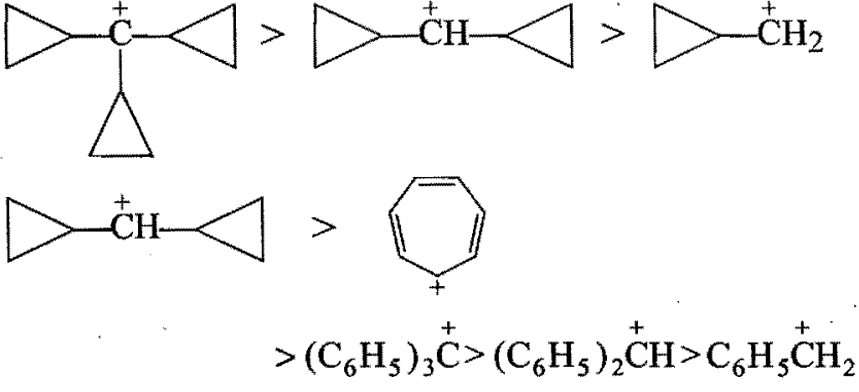
Relative stability of carbocations are :
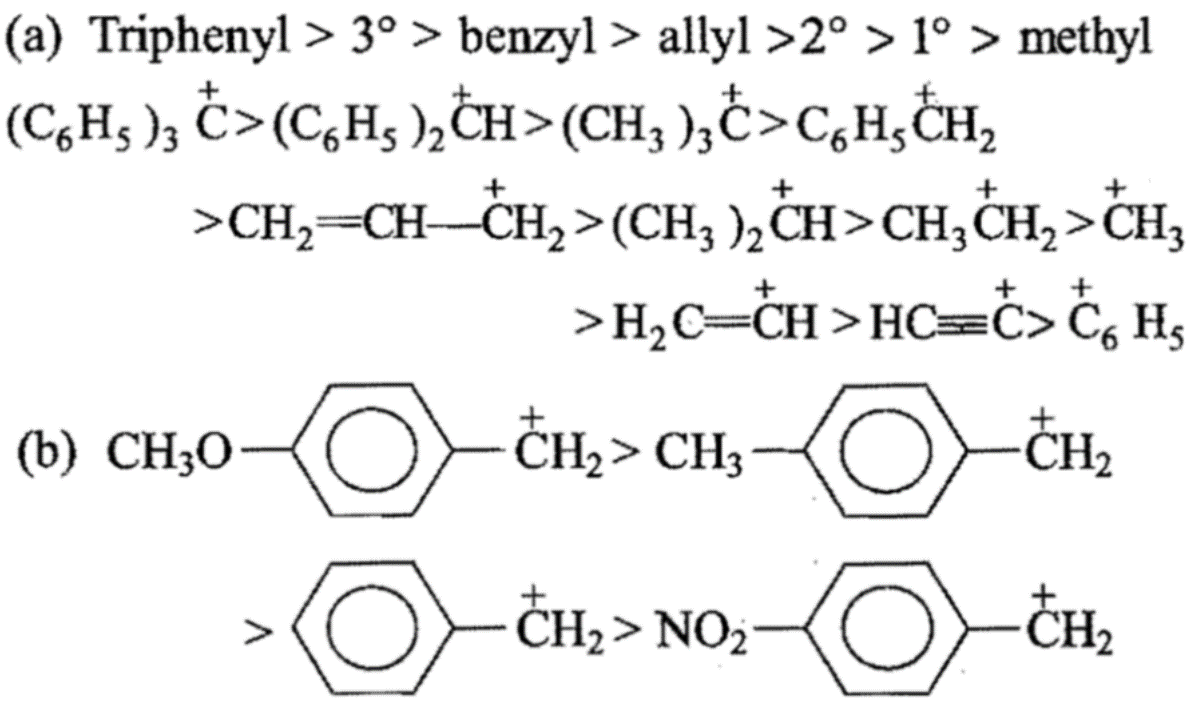
The groups like -NO2, -CN and, -Br (electron attracting) which have −I effect reduce the stability of carbocations.
Rearrangement Reactions
Rearrangement refers to structural changes within a species rearrangements in general are of two types :
(A) Shifting of a group from one atom to the other.
(B) Rearrangement because of resonance.
(A) Shifting of a Group From One Atom to the Other Atom
Although shifting of a group can occur from an atom to any other atom yet most of the shifts occur to adjacent atoms only. The main reason for this shifting is presence of six valence electrons and a vacant orbital on an atom. Such an atom has tendency to complete its octet for which the group from the adjacent atom migrates with the bonding electrons. There are two different conditions around an atom with six valence electrons.
(a) When atom with six valence electrons and a vacant orbital :

In this case when a group is shifted from atom S, the octet of S becomes incomplete which is not favourable condition. So we can say that this shift will occur only if it increases stability.
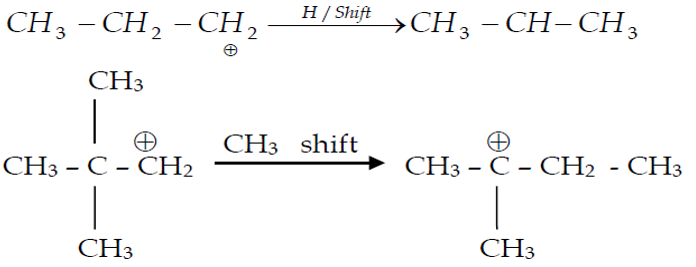
Ring expansion and ring contraction can also result because of adjacent shift.
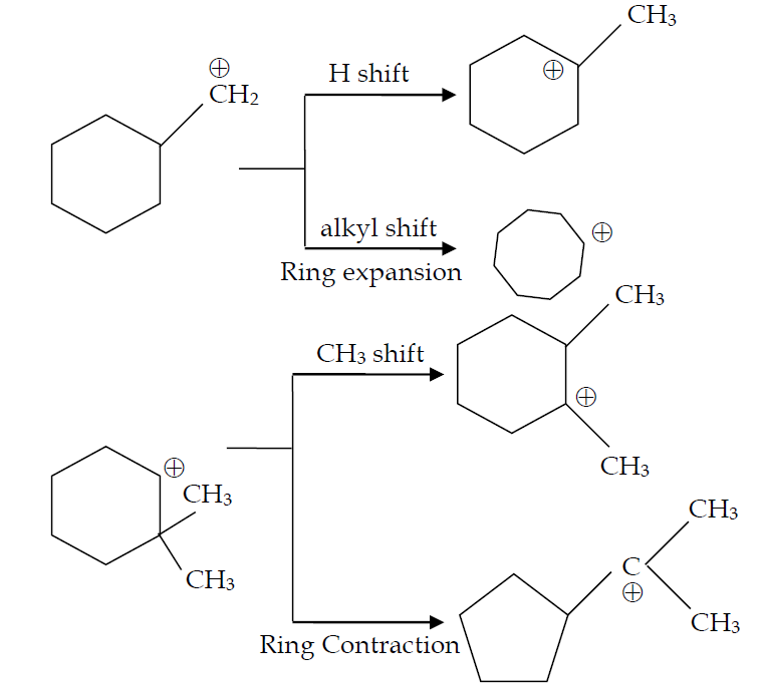
If migration of two (or more) different groups from adjacent atom can take place, major migration depends on the migrating tendency of the migrating groups (migration of group with higher migrating tendency is favoured) and the stability of resultant species (more stable resultant species is more favoured). Migrating tendency of a group is generally higher if it is more electron rich i.e. more electron donating. The general order of migrating tendency (or migratory aptitude) is as given below :

In several cases migrating tendency and the stability of resultant species favours the same migration. In such cases it will be easier to predict the major migration product.
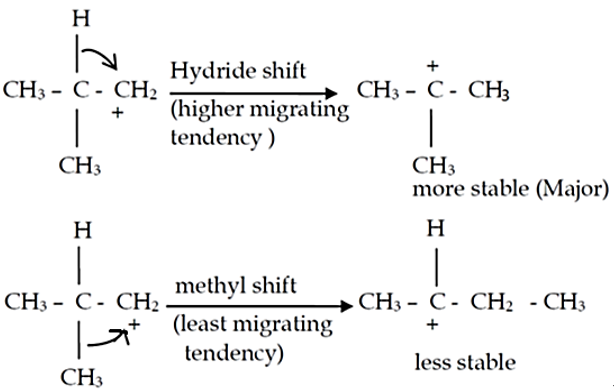
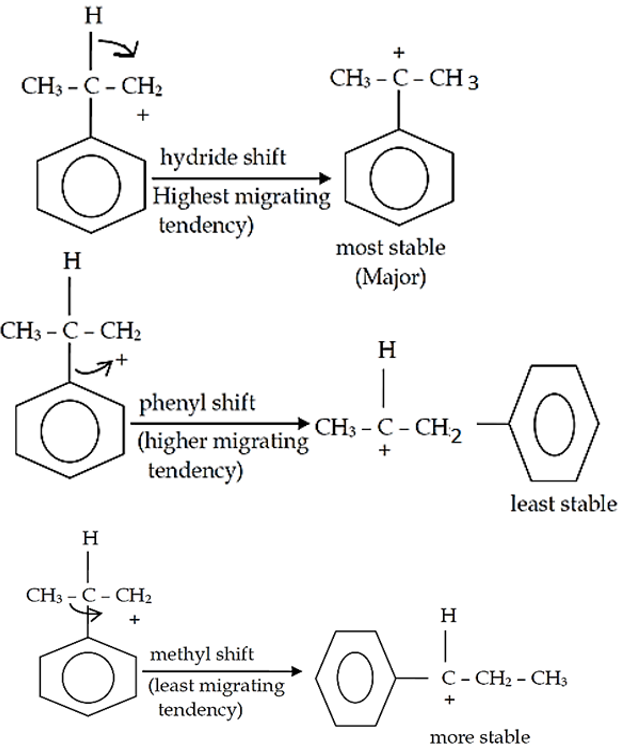
(b) When atom with six valence electrons and a vacant also has lone pair.

In this case when a group from atom B is shifted, octet of B becomes incomplete which can be completed (stabilized) by lone pairs present on A atom. Hence under these conditions stability increases always and these rearrangements are, in general, bound to take place in the given species. Moreover, in such cases formation of additional bond or stabilization by resonance of lone pair will be generally observed, therefore migrating tendency generally dominates.
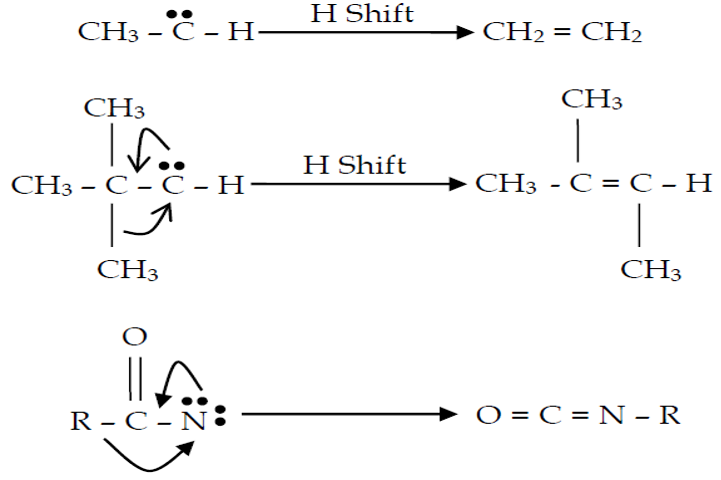
(B) Rearrangement Because of Resonance ( Allylic Rearrangement)
In these cases actually rearrangements do not occur but more than one product is formed because of the resonance in the intermediate. These rearrangements are also called pseudo rearrangements. These rearrangements are possible when the intermediates like carbocation, carbanion or carbon free radical etc. are resonance stabilized and more than one different resonating structure are possible. e.g.

Following reactions illustrate allylic rearrangements :
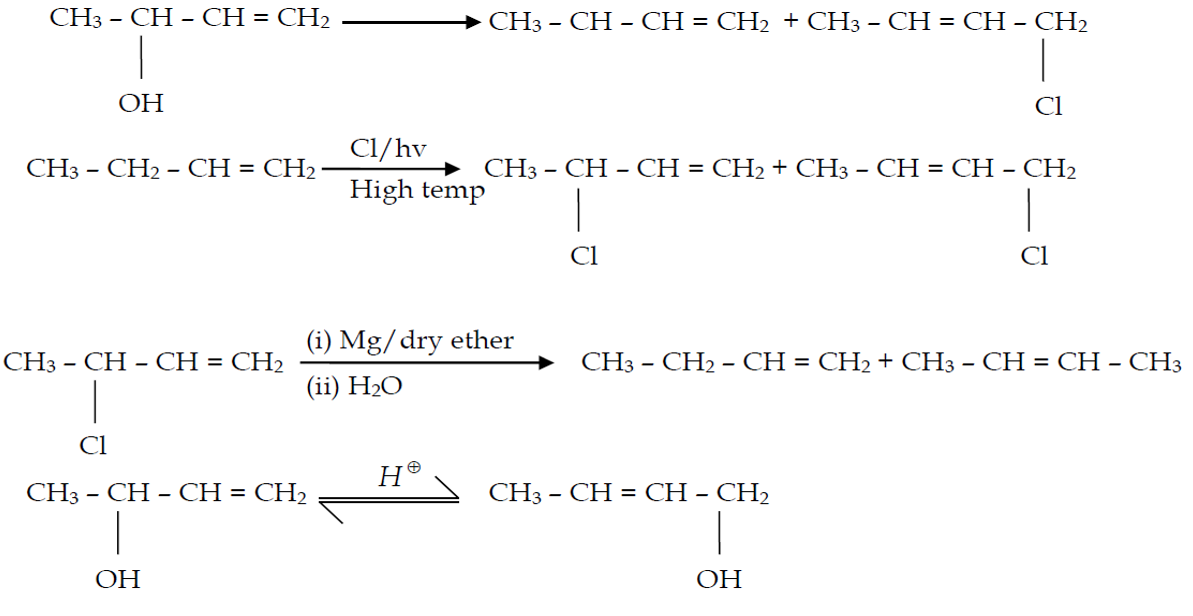
EXAMPLE 1
Arrange the following carbocations in increasing order of stability and mention basis of the order suggested.
(i) ⊕CH3 (ii) CH3⊕CH2 (iii) CH3⊕CHCH3 (iv) CH3−⊕C∣CH3−CH3
The increasing order of stability is explained on the basis of hyperconjugation which depends upon the number of α-hydrogen atoms attached to the carbon atoms linked with positively charged carbon atom. More the number of α-hydrogen atoms present, greater is the stability of the carbocation.
CH3 |⊕CH2<CH3⊕CH2<CH3−⊕CH<CH3−C⊕ | | CH3 CH3(nil) (three) (six) (nine)
EXAMPLE 2
Among the following carbocations the order of stability is :
(I) Ph2+CCH2Me
(II) PhCH2CH2+CHPh
(III) Ph2CH+CHMe
(IV) Ph2C(Me)+CH2
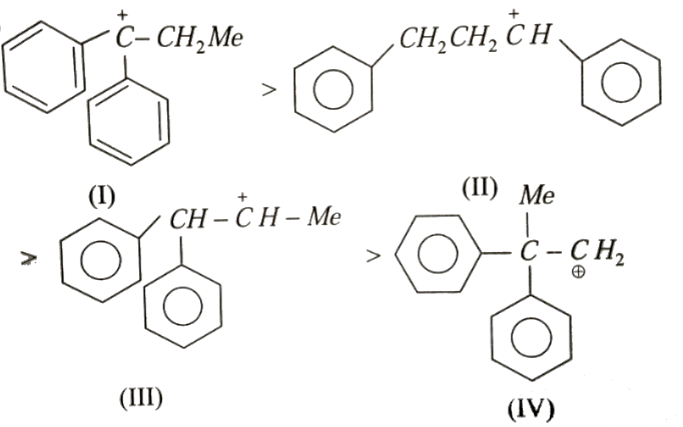
Stability of carbocation depends upon number of resonating structures and extent of +I, −I effect.
Demjanov Rearrangement
Rearrangement reaction of carbocations formed by diazotization of primary amines leading to the formation of rearranged alcohols is termed as Demjanov rearrangement. Thus, n-propylamine on treatment with nitrous acid yields minor amount of n-propyl alcohol together with a major proportion of isopropyl alcohol.

This reaction makes the basis of Demjanov's method of contracting and expanding alicyclic ring systems. Ring contraction takes place when a positive charge is formed on an alicyclic carbon, and ring expansion occurs when the positive charge is placed on a carbon a to an alicylic ring.

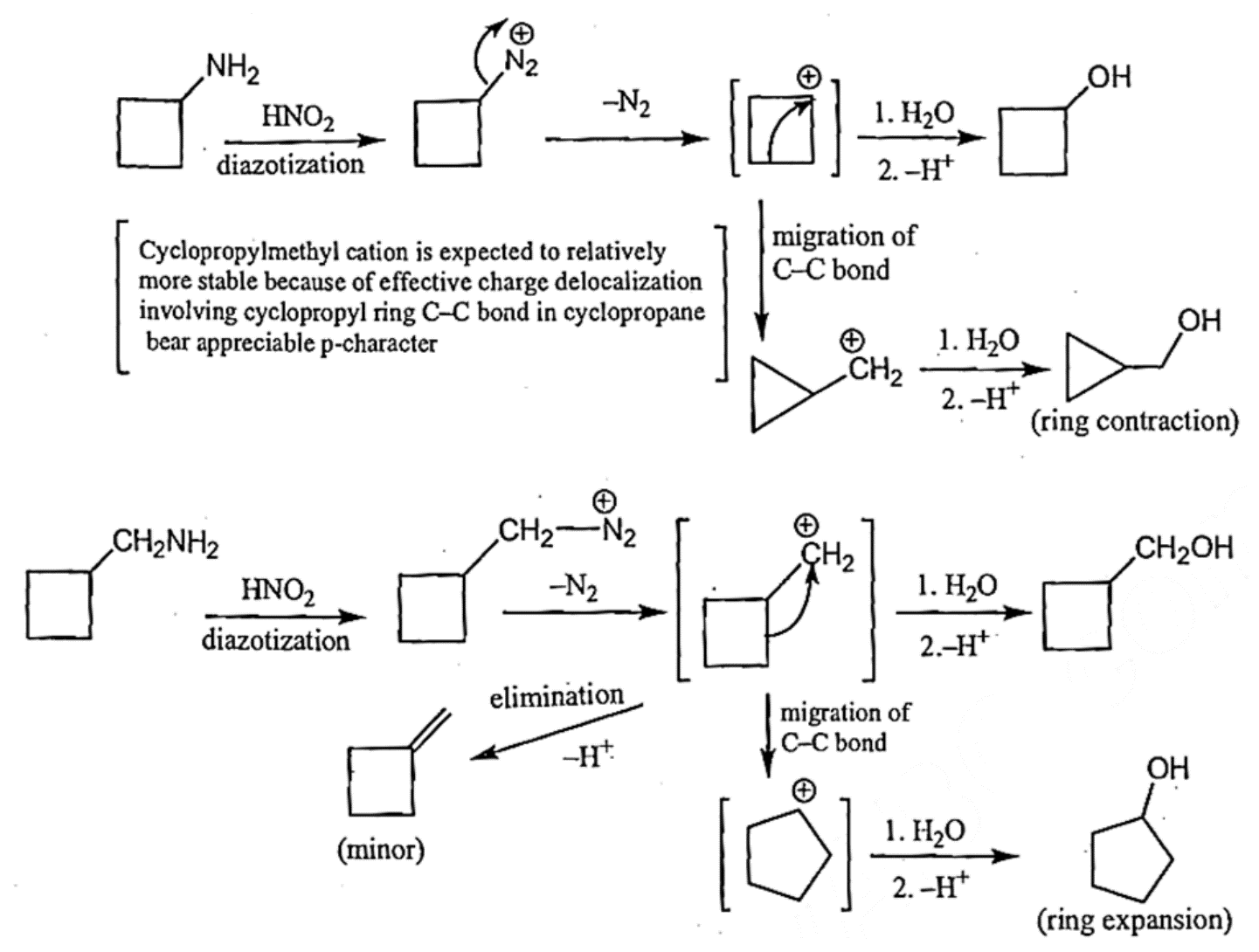
Pinacol-Pinacolone Rearrangement
The acid-catalyzed rearrangement of vic-diols (1,2-glycols) to aldehydes or ketones is called the pinacol rearrangement.
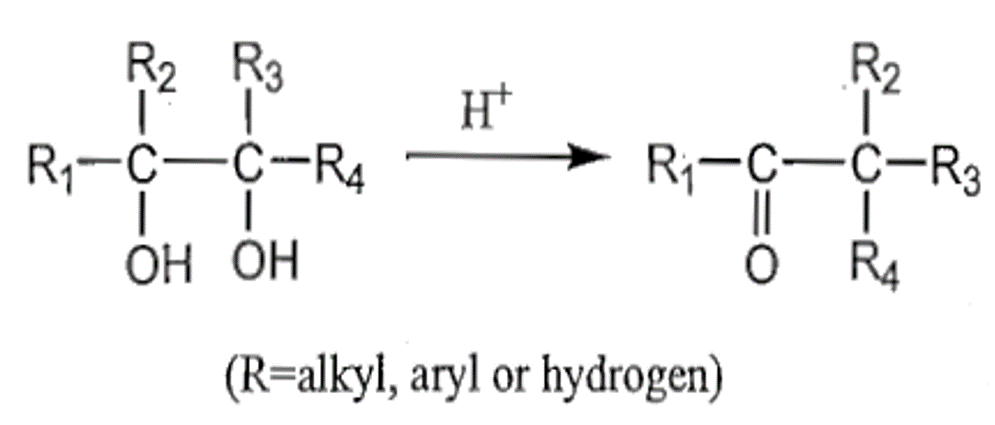
The name is originated from the classical example of conversion of pinacol to pinacolone.
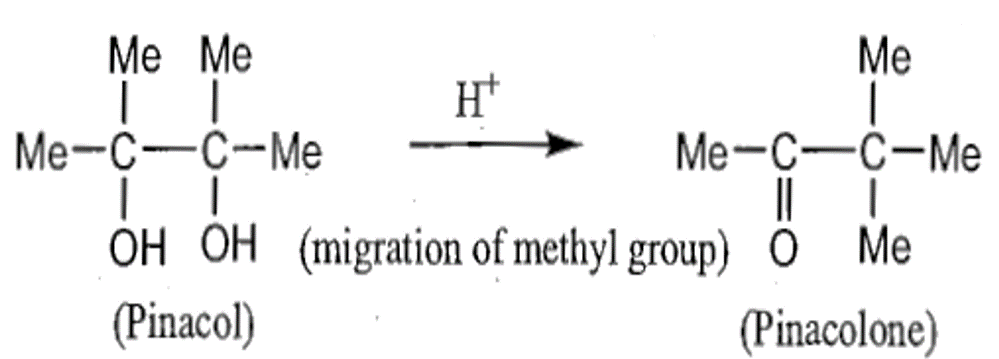
The migrating group maybe alkyl, aryl, hydrogen, and even ethoxycarbonyl (COOEt)3. However, elimination of water to yield alkene the normal reaction of alcohols may be observed as a side-reaction.
Mechanism :

Dienone-Phenol Rearrangement
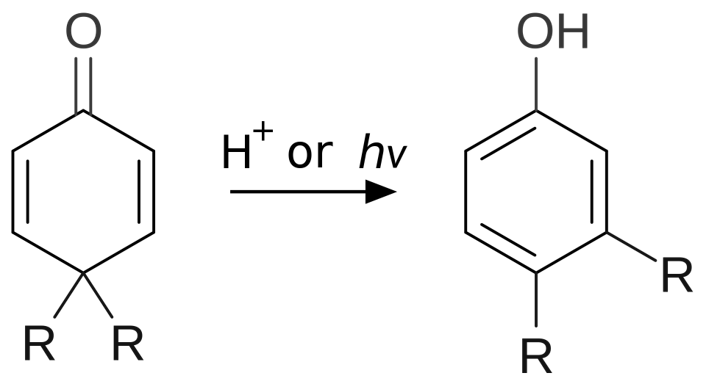
A common example of dienone-phenol rearrangement is 4,4-disubstituted cyclohexadienone converting into a stable 3,4-disubstituted phenol in presence of acid. A similar rearrangement is possible with 2,2-disubstituted cyclohexadienone to its corresponding disubstituted phenol.

Electrophilic Addition Reactions
Addition to Carbon-Carbon Multiple Bond
Addition to a Carbon-carbon multiple bond may be initiated by an electrophile, a nucleophile or a free radical. All the three reaction takes place by a two-step mechanism, the second step consisting of the combination of the resultant intermediate with a negative species, a positive species or a neutral entity.
Electrophilic Addition : In this mechanism a positive species approaches the double or triple bond and in the first step forms a σ bond by converting the π-pair of electrons into σ-pair of electrons.
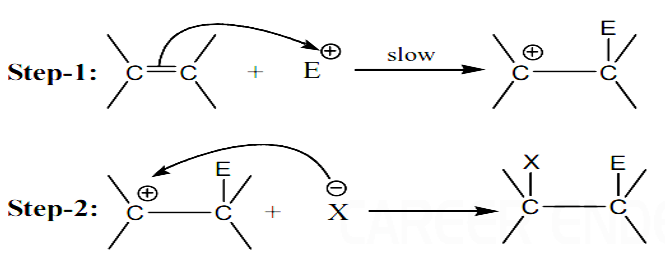
Orientation of Addition
When the electrophile being added is, unlike the halogens, non-symmetrical then with a non-symmetrical alkene, e.g. propene, the problem of orientation of addition arises : this will be the case with the hydrogen halides. These are found to add to a given alkene in the rate order:

i.e. in order of their acid strengths. This suggests rate-limiting addition of proton to the alkene, followed by rapid nucleophilic attack by Hal− to complete the addition. In non-polar solvents the proton is no doubt provided by HHal, but in polar, and especially in hydroxylic solvents, more likely by its conjugate acid, e.g. by H3O+ in H2O.
A bridged intermediate exactly analogous to a bromonium ion cannot be formed as H has no electron pair available, but it may be that in some cases a π complex (A) is the intermediate. We shall, however, normally write the intermediate as a carbocation, and it is the relative stability of possible, alternative, carbocations (e.g. C and D) that determines the overall orientation of addition, e.g. in the addition of HBr to propene (B) under polar conditions :

As secondary carbocations are more stable than primary, and in so far as this also applies to the transition states that precede them, (D) will be formed in preference to (C). In fact it appears to be formed exclusively, as the only addition product obtained is 2-bromopropane (E). Addition, as here, in which halogen (or the more negative moiety of any other unsymmetrical adduct) becomes attached to the more highly substituted of the two alkene carbon atoms is known as Markovnikov addition.
Electrophilic addition to unsymmetrical alkenes is regioselective. In the addition of hydrogen halides to a carbon-carbon double bond, proton is electrophilic and forms a hydrogen-bridged intermediate called a protium ion which is subsequently attacked from backside by the halide ion resulting in the trans addition.

According to Markovnikov’s rule: Addition of unsymmetrical alkene to unsymmetrical reagent, negative part of reagent goes to more substituted carbon atom of alkene.

But actual addition of unsymmetrical reagent to unsymmetrical alkene, negative part of reagent goes to more stabilised carbocation of alkene.

Hydrogen halide (Cl,Br) react with alkene to give addition product. Markovnikov’s rule is used for the mode of addition. Addition usually takes place to give the product with the halogen atom attached to the more substituted carbon of the double bond. The addition involves either protonation or a partial transfer of a proton to the double bond. The relative stability of the two possible carbocations from an unsymmetrical alkene favours formation of the more-substituted intermediate.

When a carbocation is not involved, the regioselectivity of electrophilic addition is the result of attack of the electrophile at the more electron rich carbon of the double bond.
Some examples
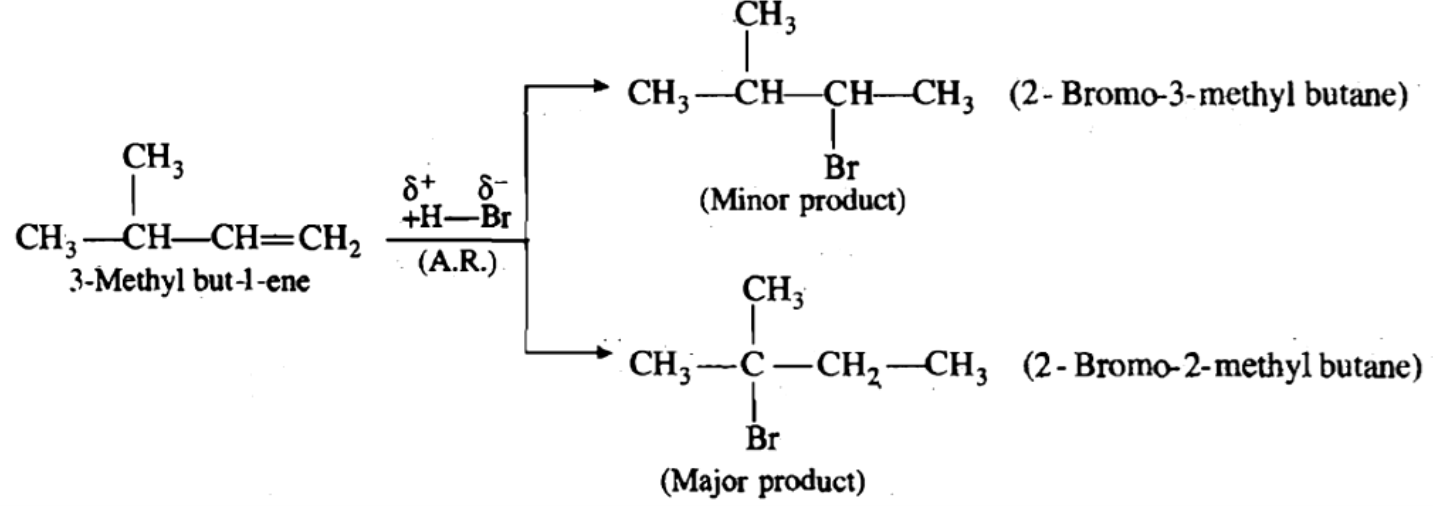
It can be explained by 1,2-hydride shift.

Other example is :
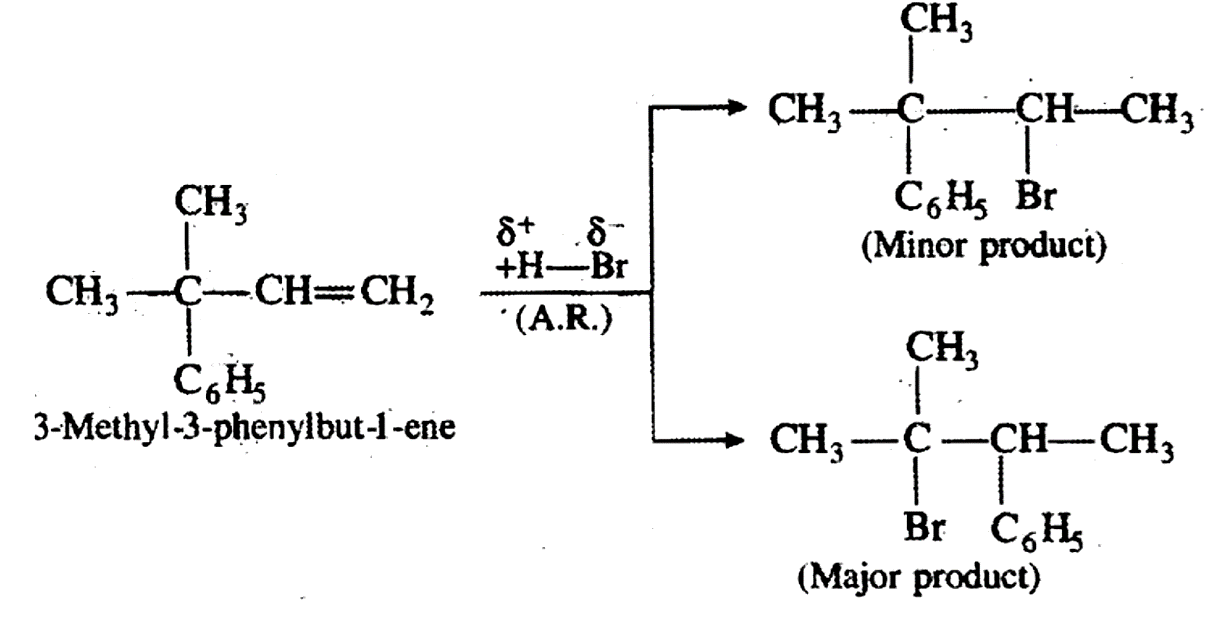
It can be explained by 1,2-phenyl shift.

Substituted Alkenes which give Addition Reaction according to Anti - Markovnikov's Rule :
Unsymmetrical alkenes having the following general structure give addition reaction according to Anti - Markovnikov's rule. Anti Markovnikov rule describes that in addition to reactions of alkenes or alkynes, the proton is added to the carbon atom that has the least number of hydrogen atoms attached to it. The Anti Markovnikov rule works against the Markovnikov rule and is called as peroxide effect or Kharasch effect.
CH2=CH−G where, G is a strong −I group such as :

Some examples are :

Stereo-selective Study (Syn & Anti Addition)
An addition that places the parts of the adding reagent on the same side (or face) of the reactant is called syn addition.

The opposite of a syn addition is an anti-addition. An anti- addition places the parts of the adding reagent on opposite faces of the reactant.

Alkene gives anti-additon product with bromine. Cis-alkene gives dl mixture and trans alkene gives meso form.

This addition proceeds through the formation of cyclic bromonium ion intermidiate when Br+ attacks π-electrons.

While trans-but-2-ene adds bromine in presence of CCl4 to give the inactive meso-product.
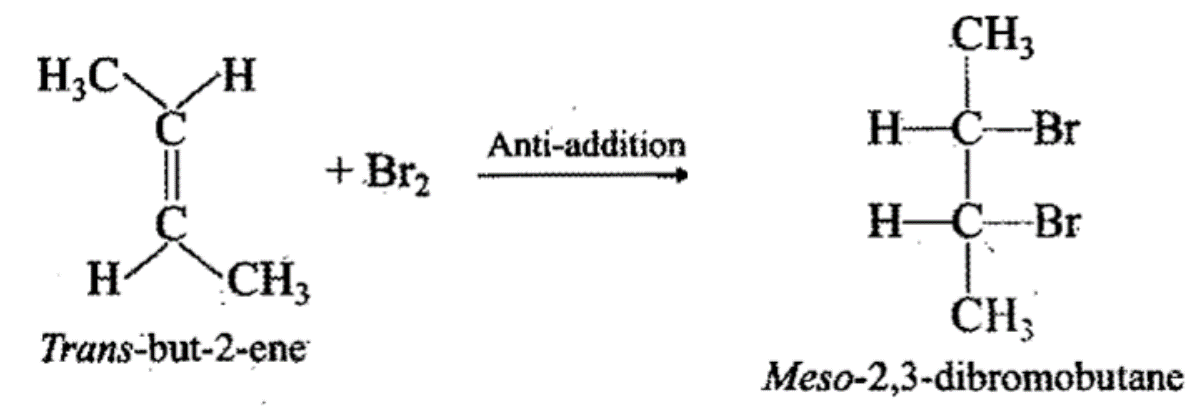
Kinetic vs Thermodynamic Control of Reactions
Like non-conjugated dienes, conjugated dienes are subjected to attack by electrophiles. In fact, conjugated dienes experience relatively greater kinetic reactivity when reacted with electrophiles than non-conjugated dienes do. The reaction mechanism is similar to other electrophilic addition reactions to alkenes. During the electrophilic addition of HBr to a 1,3-butadiene, However, there are two possible outcomes once the carbocation intermediate is formed. The allyl carbocation is stabilized by resonance structures that vary in the position of the carbocation. This allows the bromide ion to add to either of these carbons resulting in the formation 1,2 and 1,4 addition products.
When this reaction is run at a temperature of 0∘C or lower, the 1,2 addition product dominates. However, if the same reaction is run at 40∘C the 1,4 addition product dominates.
The reaction of one equivalent of hydrogen bromide with 1,3-butadiene yields different product ratios under different reaction conditions and is a classic example of the concept of thermodynamic versus kinetic control of a reaction.

At lower temperatures the formation of the 1,2 and 1,4 addition products are irreversible and thus do not reach equilibrium. When a reaction is irreversible the major product is determined by the relative reaction rates and not by thermodynamic stability. Of the two products, the formation of the 1,2 addition product has a higher rate of reaction and forms faster making it the major product. The reaction product which forms with a higher rate of reaction is called the Kinetic Product and when the kinetic product dominates, the reaction is said to be under Kinetic Control.
At higher temperatures the reaction to form both products becomes reversible and a reaction equilibrium is reached. When a reaction is reversible the major product is determined by thermodynamic stability. The 1,4 addition product is more stable and becomes the major product under these reaction conditions. The more stable product is called the Thermodynamic Product and when the thermodynamic product dominates, the reaction is said to be under Thermodynamic Control.
The 1,4 addition product is more stable because it has an internal, disubstituted double bond, and we know that as a general rule that the thermodynamic stability of an alkene increases with increasing substitution. So, when compared to the terminal, monosubstituted alkene of the 1,2 addition product, the 1,4 addition product is expected to be more stable.
What is Halaolkane & Haloarenes ?
Jab hum aliphatic or aromatic hydrocarbons se ek ya ek se jyada hydrogen atom(s) ko equal number of halogen atoms se substitute karte hai tab hume haloalkane (or alkyl halide) or haloarene (or aryl halide) compounds respectively milte hai. Haloalkane meh halogen sp3 hybridised alkyl carbon se attached hota hai aur haloarene meh halogen sp2 hybridised aryl carbon se attached hota hai. Inn compounds ki daily life meh different applications hoti hai. Isme se kuch health care sector aur medicines ki form meh bhi present hote hai. For example humari body iodine containing hormone, thyroxine produce karti hai jiski deficiency ki wajah se disease called goiter ho sakti hai, chloramphenicol, ko microorganisms produced karte hai aur ye treatment of typhoid fever ke liye very effective hota hai, chloroquine ko hum malaria treatment ke liye use karte h; halothane (CF3CHClBr) ko hum surgery meh as anaesthetic use karte hai, modern electronics industry meh hum halogenated solvents jaise ki trichloroethylene ko hum semiconductor cleaning, chips ke liye use karte hai, fully fluorinated compounds ko hum surgery meh as blood substitute use karte hai.
Haloalkanes ko generally hum RX se represent karte hai jisme R alkyl group hota hai aur X halogen hota hai (X=F,Cl,Br,I).
Haloarenes ko generally hum ArX se represent karte hai jisme Ar aryl group hota hai aur X halogen hota hai (X=F,Cl,Br,I).
What is Halaolkane & Haloarenes ?
When we replace hydrogen atom(s) of an aliphatic or aromatic hydrocarbon with an equal number of halogen atoms, it results in the formation of Haloalkane (RX) and Haloarenes (ArX) respectively. In Haloalkanes, the halogen atom(s) attached to the sp3 hybridised carbon atom of an alkyl group whereas in haloarenes, the halogen atom(s) attached to sp2 hybridised carbon atom(s) of an aryl group. The halogen containing compounds are found in nature and have medicinal use such as Chlorine containing antibiotic, chloramphenicol which is useful in treating typhoid fever. Our body produces iodine containing hormone, thyroxine, the deficiency of which causes a disease called goiter. Synthetic halogen compounds, like chloroquine are used for the treatment of malaria; halothane (CF3CHClBr) is used as an anaesthetic during surgery. In modern electronics industry, halogenated solvents such as trichloroethylene are used for cleaning semiconductors, chips and other components. Certain fully fluorinated compounds are being considered as potential blood substitutes in surgery.
Methods of Preparation of Haloalkanes or Alkyl Halides
Haloalkanes ko hum laboratory meh following methods se prepare kar sakte hai :
1) From Alcohols
Iss method se hum haloalkanes compounds ko easily laboratory meh prepare kar sakte hai. Jab hum halogen acids, phosphorus halides aur thionyl chloride ko alcohol ke sath react karte hai tab inn reactions meh halogen atom (X), alcohol ke hydroxyl group (−OH) ko substitute kar haloalkane compound generate karta hai. For example
a) By the Action of Halogen Acids : Jab hum halogen acid ko alcohol ke sath react karte hai tab ye hume haloalkane compound deta hai, iss reaction ka rate alcohol aur halogen acid par depend karta hai.
For example
(i) Jab hum primary aur secondary alcohols ko hydrochloric acid gas ke sath react karte hai tab ye hume chloroalkane compound deta hai aur iss reaction ke liye hum anhydrous zinc chloride as catalyst use karte hai aur iss process ko hum Groove’s Process bolte hai.
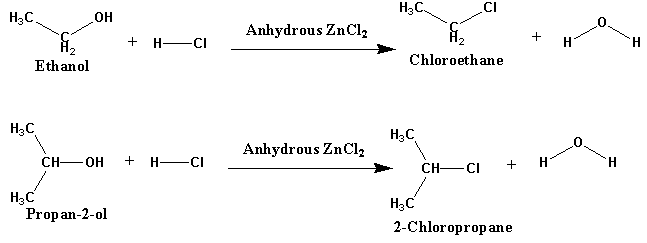
Role of ZnCl2 : Iss method meh anyd. ZnCl2,C−O bond breaking meh help karta hai. Since iss method meh ZnCl2 ek Lewis acid hai jo alcohol ke oxygen ke sath readily coordinate karta hai, iss wajah se C−O bond weak ho jata hai. As a result bond break hone par ye carbocation ka formation karta hai. Jab ye carbocation, chloride ion ke sath react karta hai tab ye chloroalkane compound ka formation karta hai.
Although tertiary alcohols highly reactive hote hai iss wajah se ye compounds room temperature par hi sirf conc. HCl ke sath reaction par hume chloroalkane compound dete hai.

(ii) Similarly, bromoalkanes compounds ko bhi hum obtained kar sakte hai aur iss reaction ke liye hum under heating conditions conc. H2SO4 as a catalyst use karte hai.

Iss reaction meh HBr unstable hota hai, isliye isko hum in situ meh conc. H2SO4 and KBr or NaBr ki reaction se obtained karte hai.

(iii) Similarly, iodoalkane compounds ko bhi hum alcohol aur hydroiodic acid ki reaction under reflux conditions se obtained kar sakte hai aur iss case meh bhi HI ko hum in situ meh phosphoric acid aur potassium iodide ki reaction se obtained kar sakte hai.

b) By the Action of Phosphorus Halides : Alcohols ko jab hum phosphorus halides ke sath react karte hai tab ye bhi hume haloalkane compound deta hai.
(i) Jab hum phosphorus trichloride aur phosphorus pentachloride ko alcohol ke sath react karte hai tab ye hume chloroalkane compound deta hai.

(ii) Similarly, bromoalkanes aur iodoalkanes compounds ko bhi hum phosphorus tribromide aur phosphorus triiodide respectively compound se obtained kar sakte hai. Lekin iss reaction meh phosphorus tribromide aur phosphorus triiodide compound stable nahi hote isliye inn compounds ko hum in situ prepare karte hai aur iske liye hum red phosphorus and Br2 or I2 ki reaction karwate hai.

c) By the Action of Thionyl Chloride : Jab hum alcohol ki reaction thionyl chloride in the presence of pyridine base meh karwate hai tab ye hume chloroalkane compound deta hai. Iss method meh jo side products bante hai SO2 aur HCl, ye dono gases hoti hai jo easily bahar nikal sakti hai as a result last meh hume pure chloroalkane compound milta hai.

2) From Hydrocarbons
Haloalkanes compounds ko hum alkanes, alkenes, alkynes compounds se hydrogen ko halogen atoms se replace kar obtained kar sakte hai.
a) From Alkanes : Jab hum alkanes ko ultraviolet light ki presence meh halogen (Cl2,Br2) se react karte hai, tab ye hume free radical substitution reaction ke basis par mono, di, polysubstituted product deta hai. Ab iss mixture of products ki wajah inka pure components meh separation difficult hota hai aur iss wajah se yahan ek particular product ki yield less hoti hai. For example,

Inn product formation ki yield nature of halogen (Cl2,Br2), number aur type of hydrogen atoms (1∘,2∘,3∘) jo substituted hai uspar depend karta hai aur generally hydrogens ka ease of substitution (3∘>2∘>1∘) sequence ko follow karta hai. Since iss reaction se hume mono substituted product ke sath di, tri or polysubstituted products bhi mil sakte hai isliye ye reaction laboratory meh haloalkanes compounds ki preparation ke liye suitable nahi hoti kyunki iss reaction se hum mixture of products ko easily separate nahi kar sakte. Lekin free radical substitution reaction kuch cases meh useful bhi hoti hai. For example :
(i) Jab mixture of products ko hum suitable method se easily separate kar sake, uss case meh ye reaction useful hoti hai. For example jab hum methane ki chlorination reaction karte hai tab ye hume jo mixture of products deta hai unme boiling point ka sufficient difference hota hai isliye inko hum fractional distillation ke through separate kar sakte hai.

(ii) Jab alkane ka structure iss tarah ho ki wo reaction ke baad hume mixture of products na de uss case meh bhi ye reaction useful hoti hai. For example neopentane, chlorination reaction par sirf ek hi product deta hai kyunki isme saare hydrogen equivalent hote hai.

(iii) Jab hydrogen atoms different types of carbon atoms ke sath attach ho tab hydrogen ki reactivity ke basis par hume sirf ek hi product milta hai. Agar hum different hydrogen atoms ka reactivity order consider kare :
Iss reactivity order se hum kah sakte hai benzylic aur allylic halides ki synthesis as compared to vinylic aur arylic halides easier hoti hai kyunki vinylic aur arylic hydrogens ki reactivity kam hoti hai iss wajah se ye free radical halogenation meh participate easily nahi karte.

Ab benzylic aur allyic hydrogens ki high reactivity, resonance stabilization of free radical intermediate ki wajah se hoti hai.

b) From Alkenes :
(i) Addition of Halogen Acids or Hydrogen Halides : Alkenes ko jab hum halogen acids se react karte hai tab ye electrophilic addition reaction ke according hume haloalkane compound deta hai.

Ab symmetrical alkene compounds meh electrophilic addition reaction sirf ek hi product deta hai kyunki isme double bonded carbon atom equivalent hote hai. For example

Lekin unsymmetrical alkene compounds meh product formation according to Markovnikov’s Rule hota hai.
Jiske according - Attacking reagent (HBr) ka negative part (Br) double bond ke uss carbon atom par add hota hai jiske pass number of hydrogen atom kam hote hai or attacking reagent ka hydrogen atom double bond ke uss carbon atom par add hota hai jiske pass number of hydrogen atom jyada hote hai.
For example in the case of propene reaction with HBr, 2-bromopropane is the major product.

Iske alawa jab hum unsymmetrical alkene ki reaction HBr ke sath in presence of organic peroxide (Example benzoyl peroxide) karte hai tab ye hume Anti-Markovnikov’s Rule ke basis par product deta hai. Jisko hum the Kharasch effect aur Peroxide effect bhi bolte hai.
Jiske according - Attacking reagent (HBr) ka negative part (Br) double bond ke uss carbon atom par add hota hai jiske pass number of hydrogen atom jyada hote hai or attacking reagent ka hydrogen atom double bond ke uss carbon atom par add hota hai jiske pass number of hydrogen atom kam hote hai.
Ye reaction free radical reaction mechanism ke basis par product formation karti hai.
For example

(ii) Addition of Halogens : Similarly jab hum Br2 or Cl2 ko alkene se react karte hai, tab ye hume vic-dihalides compound deta hai.

Similarly jab hum alkene ki bromine ke sath addition reaction karte hai in the presence of CCl4, tab bromine ka reddish brown colour, colourless hokar hume vic-dibromide product deta hai aur iss reaction se hamare compound meh double bond present hai usko hum confirm karte hai.

3) Halogen Exchange Reaction
Iodoalkanes compounds ko hum halogen exchange reaction ke through obtained kar sakte hai. Iss reaction meh hum chloroalkane or bromoalkane compounds ko conc. sodium iodide ke sath react karte hai in the presence of acetone jo hume reaction ke baad iodoalkane compound deta hai.
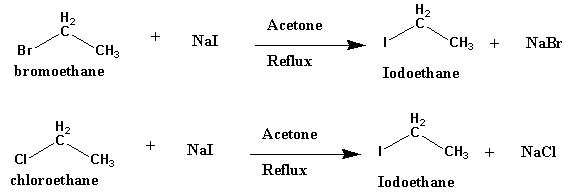
Sodium chloride aur sodium bromide, acetone meh less soluble hote hai isliye ye solution meh precipitate banate hai, jisko hum filtration se remove kar sakte hai aur issi wajah se according to Le Chatelier's principle ye forward direction meh hume iodoalkanes as product deta hai. Ye reaction generally primary halides ke sath best results deta hai aur iss reaction ko hum Finkelstein reaction bolte hai.
Similarly, fluoroalkanes compounds ki preparation difficult hoti hai. So isko prepare karne ke liye hum alkyl chlorides or bromides ko mercurous fluoride (Hg2F2), silver fluoride (AgF), cobalt fluoride (CoF3), aur antimony trifluoride (SbF3) ke sath react karte hai. Iss reaction ko hum Swarts reaction bolte hai.

Methods of Preparation of Haloalkanes or Alkyl Halides
Haloalkanes are generally prepared in the laboratory by the following methods :
1) From Alcohols
This is the most widely used method for the preparation of haloalkanes in the laboratory. The hydroxy group (−OH) of an alcohol is replaced by the halogen atom (X) by reaction with concentrated halogen acids, phosphorus halides or thionyl chloride. This can be done by the following methods :
(a) By the Action of Halogen Acids : Alcohols can be converted into haloalkanes by treatment with halogen acids. However, the rate of reaction depends on the nature of alcohol and the halogen acid both.
For example
(i) Primary and secondary alcohols form chloroalkanes when hydrochloric acid gas is passed through alcohol in the presence of anhydrous zinc chloride which is used as a catalyst. This is known as Groove's process.

Role of ZnCl2 : The purpose of anhydrous ZnCl2, is to help in the cleavage of the C−O bond. ZnCl2, is a Lewis acid therefore, it readily coordinates with the oxygen atom of the alcohols. As a result, the C−O bond weakens and finally breaks to form carbocation. The carbocation then readily reacts with chloride ion to form chloroalkanes.
Tertiary alcohols are very reactive and therefore, they react readily (simply by shaking) with conc. HCl in the absence of zinc chloride at room temperature.

(ii) Bromoalkanes are obtained in a similar manner by refluxing a suitable alcohol with hydrobromic acid (48%) in the presence of a little conc. H2SO4, which acts as a catalyst.

HBr being unstable can also be generated in situ (during the reaction) by the action of conc. H2SO4 on KBr or NaBr.

(iii) lodoalkanes are obtained by heating alcohols with constant boiling hydroiodic acid (57%). Like HBr, HI can also be generated in situ (during the reaction) by the action of 95% phosphoric acid on potassium iodide.

(b) By the Action of Phosphorus Halides : Haloalkanes can be prepared by the action of phosphorus halides on the alcohols.
(i) Chloroalkanes can be prepared by the action of phosphorus pentachloride (PCl5) or phosphorus trichloride (PCl3) on alcohols.

(ii) Bromoalkanes & Iodoalkanes are prepared by the action of phosphorus tribromide (PBr3) and phosphorus triiodide (PI3) respectively on alcohols. Since (PBr3) and (PI3), are not very stable compounds, these are generally prepared in situ by the action of red phosphorus on Br2 or I2 as :

(c) By the Action of Thionyl Chloride : Chloroalkanes can be prepared from alcohols by refluxing alcohol with thionyl chloride in the presence of an organic base, such as pyridine (C5H5N).

This method is preferred than other methods because both the other products of the reaction (SO2 and HCl) are gases which can easily escape leaving behind pure alkyl halide. Therefore, the chloro compounds can be purified easily.
2) From Hydrocarbons
The haloalkanes can be prepared from alkanes, alkenes and alkynes by the replacement of hydrogen atom by halogen atom.
a) From Alkanes
(i) Halogens (Cl2, and Br2) react with alkanes in the presence of ultraviolet light to form haloalkanes. This reaction is free radical substitution reaction, it gives a mixture of mono, di or polysubstituted haloalkanes which are difficult to separate into pure components. Moreover, the yield of any one compound is low because of the formation of other compounds. For example, in case of propane, a mixture of two isomeric products are formed even when mono substitution is carried out.

The relative amounts of these isomeric haloalkanes depend upon the nature of the halogen (Cl2 or Br2), the number and type of hydrogen (1∘,2∘or3∘) being substituted. In general, the ease of substitution of various hydrogens follows the sequence (3∘>2∘>1∘). In addition to above monochloro compounds, isomeric dichloro and trichloro compounds are also possible. Therefore, halogenation of alkanes is not a suitable method for laboratory preparation of haloalkanes. This is mainly because a mixture of different isomers are formed which are difficult to separate. However, free radical substitution is still useful in certain cases as discussed below :
(i) When the mixture of products can be easily separated by some suitable method. For example, chlorination of methane gives different products which have suitable differences in the boiling points. Therefore, these can be separated by fractional distillation.

(ii) When the structure of alkane is such that the formation of isomeric products is not possible. For example, neopentane gives only one product because all the hydrogen atoms are equivalent.

(iii) When there is a large difference in the reactivity of hydrogen attached to different types of carbon atoms only one product is formed under suitable conditions. For example reactivity of different types of hydrogens in halo compounds are :
The vinylic and arylic hydrogens are so unreactive that they do not participate in free radical halogenation reactions. Thus the benzylic and allylic halides can be easily prepared. For example

The high reactivity of benzylic and allyic hydrogens are due to the resonance stabilization of free radical intermediate which is formed during the reaction.

b) From Alkenes
(i) Addition of Hydrogen Halides or Halogen Acids : Haloalkanes can be prepared by the electrophilic addition of halogen acids (HBr,HClorHI) to alkenes.

It may be noted that in case of addition to symmetrical alkenes (−HC=CH−), the carbon atoms joined by the double bond are equivalent and therefore, only one addition product is formed. For example,

During the addition of halogen acids to unsymmetrical alkenes, Markovnikov’s rule is followed. According to this rule,
During the addition across unsymmetrical double bond, the negative part (Br) of the attacking reagent (HBr) attaches itself to the carbon atom carrying lesser number of hydrogen atoms while the positive part goes to the carbon atom with more number of hydrogen atoms.
For example, in the case of propene reaction with HBr, 2-bromopropane is the major product.

However, it has been observed that when HBr is added to an unsymmetrical double bond in the presence of organic peroxide such as benzoyl peroxide (C6H5CO−O−O−COC6H5) the reaction takes place opposite to Markovnikov’s rule. This is known as anti-Markovnikov rule or peroxide effect. It is also called the Kharasch effect. According to the anti Markovnikov's rule,
In the case of addition of HBr to unsymmetrical alkene, the negative part of the attacking reagent (Br) will join to the carbon atom carrying more hydrogen atoms while H-atom will go to the other carbon atom containing lesser number of hydrogen atoms.
For example,

(ii) Addition of Halogens : When Br2, or Cl2, is added to alkenes, the addition occurs at the double bond forming vic-dihalides.

Similarly, when bromine in CCl4 is added to ethene, the reddish brown colour of bromine gets discharged due to the formation of vic-dibromide, which is colourless. This is an important test for the detection of double bond.

3) By Halogen Exchange
This reaction is particularly useful for preparing iodoalkanes. The iodoalkanes are obtained by heating chloro or bromoalkanes with a concentrated solution of sodium iodide in acetone.

Sodium chloride and sodium bromide being less soluble in acetone get precipitated from the solution and can be removed by filtration. This also prevents the backward reaction to occur according to Le Chatelier's principle. The reaction gives the best results with primary halides. This reaction is known as Finkelstein reaction.
Fluoroalkanes are difficult to prepare directly. These are prepared by treating alkyl chlorides or bromides with salts such as mercurous fluoride (Hg2F2), silver fluoride (AgF), cobalt fluoride (CoF3) or antimony trifluoride (SbF3). This reaction is known as Swarts reaction.

Methods of Preparation of Haloarenes or Aryl Halides
Haloarenes ko commonly hum following methods se prepare kar sakte hai :
1) From Hydrocarbons by Electrophilic Substitution Method
Aryl chloride or aryl bromide ko hum benzene or dusre hydrocarbons compounds ki direct chlorination or bromination reaction se obtained kar sakte hai. Electrophilic substitution reaction dark, ordinary temperature (310-320 K) aur in the presence of lewis acids catalysts anhydrous ferric chloride (FeCl3) or anhydrous aluminium chloride (AlCl3) ki presence meh hoti hai. Lewis acid catalyst iss reaction meh halogen carrier ki tarah kaam karta hai kyunki ye halogen ko aromatic hydrocarbon tak le jata hai.
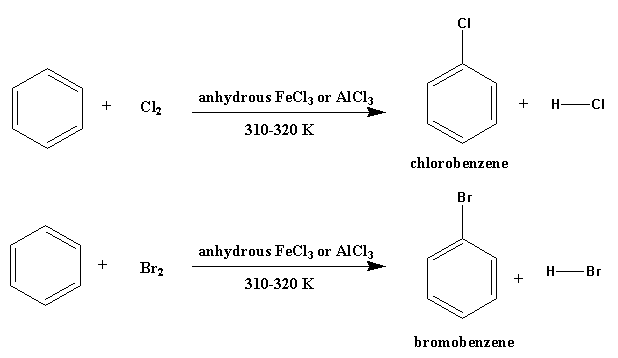
Ab agar hum excess of halogen ke sath aryl chloride aur aryl bromide compound ki halogenation reaction kare tab second halogen first ki respect meh o- aur p- positions par substitute hota hai kyunki halogen o- aur p- directing groups ki tarah kaam karta hai aur ortho and para isomers ko hum inke melting point ke difference ki basis par differentiate kar sakte hai.

Similarly reaction hum bromo compounds meh bhi observe kar sakte hai aur usme reagent Br2 aur FeBr3 use karte hai. Lekin fluoro compounds ki reaction violent hoti hai aur control nahi ki ja sakti iss wajah se fluoroarene compounds ko hum direct fluorination reaction se obtained nahi kar sakte. Similarly iodoarene compounds ki preparation bhi difficult hoti hai aur isko bhi hum direct iodination se obtained nahi kar sakte kyunki ye reversible reaction hoti hai aur iss reaction meh HI jo banta hai wo ek strong reducing agent ki tarah kaam karta hai jo further iodobenzene ke sath reaction par benzene compound regenerate kar deta hai.

Iss wajah se iodination reaction ko hum in the presence of iodic acid (HIO3), nitric acid (HNO3) etc., oxidising agent ki presence meh karte hai jo further HI ko iodine I2 meh oxidise kar hume final major product iodobenzene deta hai.
.png.png)
2) From Diazonium Salts
Jab hum freshly prepared diazonium salt solution aur cuprous chloride or bromide ko halogen acid meh dissolve kar reaction karte hai tab ye hume chloro aur bromoarene compound deta hai. Iss reaction ko hum Sandmeyer’s reaction bolte hai.
Ab iss reaction meh jo reactant benzene diazonium chloride salt hai uski preparation hum aniline, sodium nitrite, excess of dil. HCl ki reaction at 273−278 K (0−5∘C) temperature par karne se obtained kar sakte hai. Iss reaction ko hum diazotization reaction bolte hai.
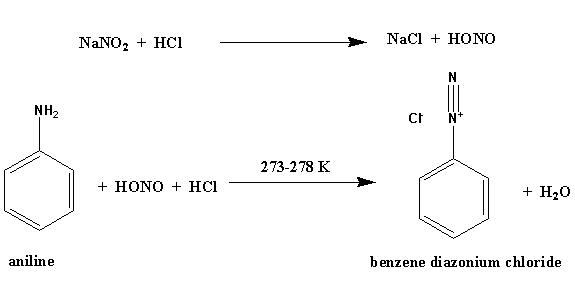
Iss benzene diazonium salt ki reaction jab hum cuprous chloride or bromide ke sath in HCl or HBr karte hai tab ye hume required product deta hai.

Lekin iodoarene compounds ki preparation ke liye hum benzene diazonium chloride salt ko directly aqueous potassium iodide solution ke sath react kar obtained kar sakte hai.
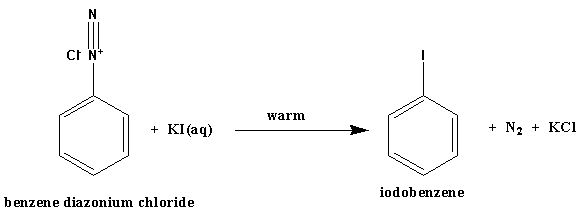
Similarly, fluoroarenes compounds ki preparation ke liye hum benzene diazonium chloride salt ko fluoroboric acid ke sath react karte hai jo initially benzene diazonium fluoroborate salt deta hai jisko further heating karne par ye hume fluorobenzene compound deta hai. Iss reaction ko hum Balz-Schiemann reaction bolte hai.

Methods of Preparation of Haloarenes or Aryl Halides
Haloarenes are commonly prepared by the following methods :
1) From Hydrocarbons by Electrophilic Substitution Method
Chloroarenes (aryl chlorides) and bromoarenes (aryl bromides) can be easily prepared by direct chlorination or bromination of benzene or other aromatic hydrocarbons. These reactions are carried out in dark, at ordinary temperatures (310−320 K) in the presence of Lewis acid catalyst such as anhydrous ferric or aluminium halides (FeCl3,FeBr3,AlCl3). These reactions are called electrophilic substitution of arenes. The Lewis acid acts as a catalyst and its function is to carry the halogen to the aromatic hydrocarbon due to this is also called halogen carrier.

If excess of halogen is used, the second halogen also gets introduced in the ring mainly at o- and p- with respect to the first halogen because halogens are o- and p- directing groups. The ortho and para-isomers can be easily separated due to large differences in their melting points.

Bromo compounds can be prepared in a similar way by reacting with Br2, in the presence of FeBr3. The reaction with fluorine is violent and cannot be controlled. Therefore, fluoroarene cannot be prepared by direct fluorination of aromatic hydrocarbon. Iodoarenes are also difficult to prepare and these cannot be prepared by direct iodination because the reaction is reversible and HI produced is a strong reducing agent to reduce iodobenzene back to benzene.

Therefore, the reaction is carried out in the presence of an oxidising agent like iodic acid or nitric acid etc., which oxidises HI formed in the reaction to iodine. This enables the reaction to proceed in the forward direction.
.png.png)
2) From Diazonium Salts
Chloro and bromoarenes are prepared by treating a freshly prepared diazonium salt solution with cuprous chloride or cuprous bromide dissolved in corresponding halogen acids. This reaction is called Sandmeyer reaction.
The benzene diazonium salt required for this purpose is prepared by treating excess dilute HCl with an aqueous solution of sodium nitrite at low temperature, 273-278 K (0−5∘C). The reaction is known as diazotization reaction.

The benzene diazonium salt is used for preparing aryl halides as :

However, for preparing iodoarenes, replacement of the diazonium group by iodine does not require the presence of cuprous halides and is done simply by shaking the diazonium salt solution with aqueous KI solution.

Fluoroarenes are prepared by treating benzene diazonium chloride with fluoroboric acid. This reaction first produces diazonium fluoroborate which on heating produces fluorobenzene.

The reaction is called Balz-Schiemann reaction.
EXAMPLE 3
Draw and name all monochloro products you would expect to obtain from free radical chlorination of 2-methyl pentane.
Monochloro products from 2-methyl pentane:
CH3CH∣CH3CH2CH2CH3
(i) ClCH2CH∣CH3CH2CH2CH31-Chloro-2-methylpentane (ii) CH3Cl∣C∣CH3CH2CH2CH32-Chloro-2-methylpentane
(iii) CH3CH∣CH3−CH∣ClCH2CH33-Chloro-2-methylpentane (iv) CH3CH∣CH3CH2C∣ClHCH32-Chloro-4-methylpentane
(v) CH3CH∣CH3CH2CH2CH2Cl1-Chloro-4-methylpentane
EXAMPLE 4
Write the equations for the preparation of 1-iodobutane from
(i) 1-butanol , (ii) 1-chlorobutane , (iii) but-1-ene
(i) CH3CH2CH2CH2Butan-1-olOH+HI→CH3CH2CH2CH2I1-Iodobutane+H2O
(ii) CH3CH2CH2CH2Cl1-Chlorobutane+NaI(acetone)−−−−−→CH3CH2CH2CH2I+NaCl1-Iodobutane
(iii) CH3CH2CH=CH2But-1-ene+HBr(peroxide)−−−−−−→CH3CH2CH2CH21-BromobutaneBrNaI−−−−−−→(Acetone)CH3CH2CH2CH2I1-Iodobutane
Chemical Reactions of Haloalkanes
Haloalkanes compounds ki reactions ko 3 types meh divide kiya jata hai :
1) Nucleophilic Substitution Reaction
2) Elimination Reactions
3) Reaction with Metals
Nucleophilic Substitution Reaction
Haloalkanes compounds meh carbon atom halogen atom se bonded hota hai, ab halogen atom ki electronegativity in comparison to carbon atom jyada hoti hai iss wajah se C−X bond polar nature show karta hai jis wajah se carbon par partial positive aur halogen par partial negative charge generate ho jata hai. Ab polar nature hone ki wajah se haloalkane compounds highly reactive hote hai.

Haloalkane C−X bond meh carbon par partial positive charge hone ki wajah se iska carbon atom electron deficient species ki tarah kaam karta hai matlab iss carbon ko electron rich species (or nucleophile) apne electrons donate kar sakta hai. Isme jab nucleophile, halide ion se stronger hota hai, tab ye positively charged carbon atom par attack kar halide ion ko displace karta hai aur new carbon-nucleophile (C−Nu) bond form karta hai jis wajah se iss reaction ko hum nucleophilic substitution reaction bolte hai.

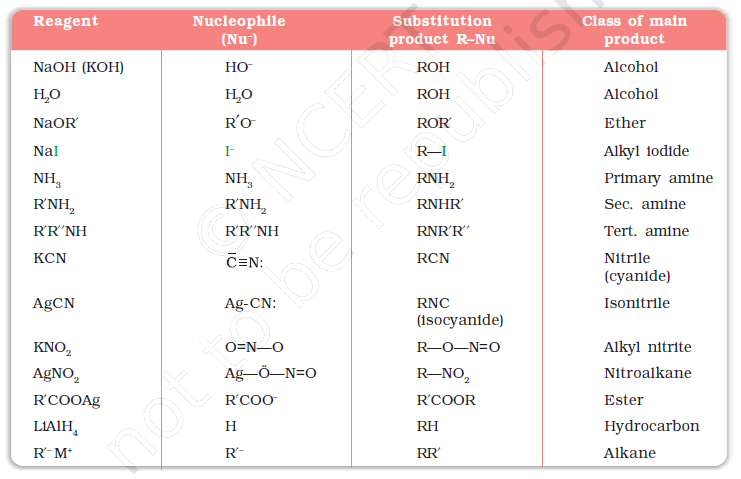
Iss reaction meh jo atom or group of atoms carbon ke sath bond break karta hai aur extra pair of electron ko lekar bahar nikalta hai usko hum leaving group bolte hai. Halide ions generally good leaving group hote hai aur iss reaction ke liye jitna jyada better leaving group hota hai, uss case meh utni hi fast nucleophilic substitution reaction hoti hai.
In case of alkyl halides, halides ka following leaving group trend hota hai.
Kuch cases meh groups jaise cyanide aur nitrite bhi reaction karte hai, inke pass 2 nucleophilic centres hote hai aur inn nucleophiles ko hum ambident nucleophiles bolte hai.
a) Cyanide (CN−) ke case meh nucleophilic centre carbon aur nitrogen hote hai so jab attack carbon side se hota hai tab ye alkyl cyanide compound R−CN form karta hai aur jab attack nitrogen side se hota hai tab ye alkyl isocyanide compound R−NC form karta hai.
b) Nitrite (NO2) ke case meh nucleophilic centre nitrogen aur oxygen hote hai so jab attack nitrogen side se hota hai tab ye nitroalkane compound R−NO2 form karta hai aur jab attack oxygen side se hota hai tab ye alkyl nitrite compound R−O−N=O form karta hai.
Types of Nucleophilic Substitution Reaction
Nucleophilic substitution reaction 2 types ki hoti hai :
(i) Substitution Nucleophilic Bimolecular, (SN2)
(ii) Substitution Nucleophilic Unimolecular, (SN1)
(i) Substitution Nucleophilic Bimolecular, (SN2)
Jab hum methyl chloride aur hydroxide ion ki reaction karte hai tab ye methanol compound generate karta hai aur ye reaction second order kinetics follow karti hai, jisme rate dono reactants methyl chloride aur hydroxide ion ki concentration par depend karta hai.
Iss reaction ke rate ko hum iss tarah represent kar sakte hai.
Ab agar hum in general alkyl halide ka case consider kare,
Ab kyunki iss reaction meh 2 molecules rate of reaction ko determine kar rahe hai isliye iss reaction ko hum nucleophilic substitution bimolecular reaction bolte hai jisko hum (SN2) se bhi represent karte hai. Ye reaction single step through transition state hoti hai. Iss reaction meh nucleophile OH−, partially positive charge carbon atom ko carbon-halogen bond ke backside se attack karta hai. Tab ye initially transition state banata hai jisme C…..OH bond partially form hota hai aur C….Cl bond partially break hota hai. Transition state form hone ki wajah se ye reaction one step meh hoti hai, iss transition state meh negative charge nucleophile OH− aur chloride ion ke beech share hota hai.
Iss reaction meh jab nucleophile OH− apne electrons partial positive charge carbon atom ko deta hai, tab side by side chloride apne electrons carbon se remove karta hai jis wajah se nucleophile OH− aur chloride ion par partial negative charge δ− hota hai. Ab transition state meh carbon ke sath jo 3 aur bonds hote hai wo yahan planar structure form kar lete hai. Since transition state meh carbon 5 atoms ke sath bond banata hai jis wajah se transition state stable nahi hoti. So isko stable karne ke liye chloride ion iss state ko leave karta hai aur hume ek stable product deta hai jisme C−OH bond form hota hai. For example

Iss reaction ke through hume ye pata chala ki SN2 reaction meh transition state rate determining step hai jiske according hum ye kah sakte hai ki iss reaction ka rate alkyl halide aur nucleophile OH− ki concentration par depend karta hai, iss wajah se ye reaction second order kinetics or bimolecular reaction hoti hai.
Reactivity of Alkyl Halides towards SN2 reaction
SN2 reaction meh alkyl halide reactivity ka generally following trend hota hai :
Ab aisa kyun hota hai ? Isko samjhne ke liye hum formation aur stability of transition state ko study karte hai. Ab iss reaction meh nucleophile, carbon-halogen bond ke carbon atom par piche se attack karta hai, lekin agar iss carbon atom se bulky group attach ho tab nucleophile iss carbon atom par easily attack nahi kar payega. Jis wajah se iss reaction ka rate slow ho jata hai. Ab yahan bulky group ke present hone ki wajah se jo reaction ke rate par effect hota hai usko hum steric hindrance bolte hai. Iss wajah se SN2 reaction, simple alkyl halides jaise methyl halide compounds easily de pate hai, kyunki iss case meh carbon atom 3 hydrogen atoms ke sath attach hota hai (least steric hindrance). Lekin agar hum tertiary alkyl halide compounds consider kare toh isme 3 bulky groups (maximum steric hindrance) present hote hai jis wajah se ye compounds SN2 reaction meh least reactive hote hai. Iss wajah se inka following order hota hai :

Figure : Steric effects in SN2 reaction. The relative rate of SN2 reaction is given in parenthesis.
(ii) Substitution Nucleophilic Unimolecular, (SN1)
Jab hum tert-butyl bromide aur hydroxide ion ki reaction karte hai tab ye hume tert-butyl alcohol deta hai aur ye reaction first order kinetics ko follow karta hai kyunki isme rate sirf ek reactant alkyl halide ki concentration par depend karta hai.

Iske rate ko agar hum express kare :
or Rate=k[RX]
Ab kyunki iss reaction meh sirf 1 hi molecule rate of reaction ko determine kar raha hai isliye iss reaction ko hum nucleophilic substitution unimolecular reaction bolte hai jisko hum (SN1) se bhi represent karte hai. Ye reaction polar protic solvents jaise water, alcohol, acetic acid etc., meh hoti hai. Ye reaction 2 steps meh hoti hai jisme 1st step meh carbocation ka generation hota hai aur 2nd step meh nucleophile, carbocation intermediate par attack karta hai.
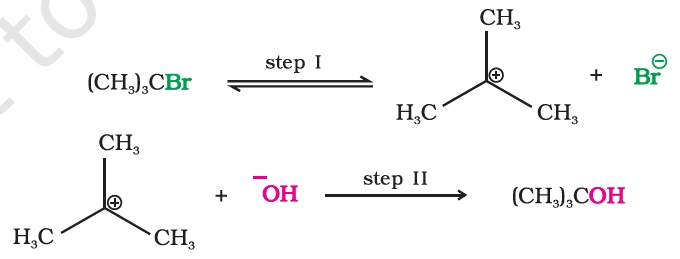
Iss reaction ka 1st step slow or reversible hota hai, iss step meh C−Br bond ka cleavage hota hai jisko break karne ke liye energy solvation of bromide (halide) ion with the proton of protic solvent se milti hai. Ab kyunki rate determining step slowest step hota hai, iss wajah se iss reaction ka rate sirf tert-butyl bromide (alkyl halide) ki concentration par depend karta hai. Iss wajah se ye reaction first order kinetics aur unimolecular reaction hoti hai.
Reactivity of Alkyl Halides towards SN1 reaction
Since iss reaction ka rate determining step carbocation formation hota hai, iss wajah se ye reaction carbocation ki stability par depend karti hai. Ab jitni jyada carbocation ki stability hoti hai utni easily alkyl halide, carbocation form kar sakta hai aur utni hi fast wo alkyl halide SN1 reaction show karta hai. Ab jaise ki hume pata hai ki tertiary carbocation most stable hota hai so issi wajah se tert-alkyl halide ke case meh SN1 rate of reaction fast hota hai.
Lekin allylic aur benzylic halides ki reactivity tertiary alkyl halides se bhi jyada hoti hai in SN1 reaction kyunki allylic aur benzylic carbocation, resonance ki wajah se jyada stable hote hai.

Comparison of Rate of Reactivity of SN1 and SN2 reaction :

Stereochemical Aspects of Nucleophilic Substitution Reactions
Nucleophilic substitution reaction ki mechanism ko samjhne ke liye stereochemistry ek important role play karti hai. For example SN2 reaction stereochemical inversion of configuration ke sath aur SN1 reaction racemisation ke sath product deti hai. Ab ye terms actual meh hoti kya hai isko hum discuss karte hai.
(i) Optical Activity
Jab kuch compounds ke solutions (such as sugar, camphor) ko hum plane polarised light ke path meh rakhte hai tab ye plane polarised light ko left or right direction meh rotate karta hai, accordingly tab inn compounds ko hum optically active compounds bolte hai. Ab agar ye compounds plane polarised light ko right direction meh rotate kare tab isko hum dextrorotatory compounds bolte hai aur isko hum d− se or sign (+) se represent karte hai. Similarly, agar ye compounds plane polarised light ko left direction meh rotate kare tab isko hum laevorotatory compounds bolte hai aur isko hum l− se or sign (−) se represent karte hai. For example lactic acid, glucose etc. aur jis instrument se hum plane polarised light ki direction aur magnitude ko measure karte hai usko hum polarimeter bolte hai.
Lekin jo compounds plane polarised light ko rotate nahi karte hai unko hum optically inactive compounds bolte hai. So accordingly,
This property of a substance to rotate the plane of polarised light either towards right or towards left is called optical activity.
Jo compounds (+) and (−) dono isomeric form show karte ho unko hum optical isomers bolte hai aur iss phenomena ko hum optical isomerism bolte hai.
(ii) Molecular Asymmetry, Chirality and Enantiomers
Ab kuch substances ke crystals aise bhi hote hai jo khud ki mirror image bana sakte hai. For example sodium ammonium tartrate. Inn compounds ki optical rotation ki magnitude same hoti hai lekin inki direction opposite hoti hai. Iss difference of optical rotation ko three dimensional arrangement of atoms meh configuration bolte hai.
On a similar note jab carbon atom ki 4 valencies 4 different atoms or groups tetrahedron arrangement meh occupy karte hai, tab uss carbon atom ko hum asymmetric carbon or stereocenter bolte hai. Ab jis molecule meh asymmetric carbon present hota hai uske paas symmetry nahi hoti iss wajah se inn molecule ko hum asymmetric molecule bolte hai. Iss asymmetry of molecule ki wajah se compounds optical activity show kar pate hai. Asymmetry or symmetry ko daily life meh consider kare toh
All objects or molecules have mirror images.
An object or a molecule which is not superimposable on its mirror image is called chiral.
For example human hand, jab hum apne left hand ko right hand ke oopar rakhte hai, tab dono hands ek dusre ko superimpose nahi karte. Iss wajah se hamare hands chiral hote hai, similarly gloves, shoes etc., bhi chiral hote hai aur iss property ko chirality bolte hai. Lekin kuch substances aise bhi hote hai jo apni mirror image ke ekdum identical hote hai unko hum achiral substance bolte hai for example cup, fork, spoon, cube etc., matlab ye substances ek dusre ki mirror image par superimpose karte hai.
Those objects which are superimposable on their mirror images are called achiral.
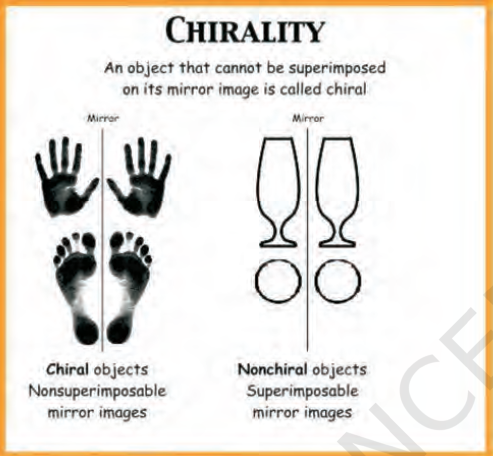
Figure : Some common examples of chiral and achiral objects
Ab ye property organic molecules bhi show kar sakte hai aur iss case meh
The molecules which are not superimposable on their mirror images are called chiral molecules. The property of non-superimposability of a structure on its mirror image is called chirality.
Similarly, molecules which are superimposable on their mirror images are called achiral molecules.
Generally jo chiral molecules hote hai wo optically active aur jo achiral molecules hote hai wo optically inactive hote hai.
Iss concept ko organic molecules ke case meh samjhne ke liye hum pehle propan-2-ol compound consider karte hai.
Ab propan-2-ol compound meh koi bhi asymmetric carbon atom present nahi hai matlab iss compound meh kisi bhi carbon atoms se 4 different groups or atoms attach nahi hai. Iss wajah se ye achiral molecule hai. Isko confirm karne ke liye hum iss compound ka pehle 3-dimensional structure consider karte hai (A), similarly iski mirror image structure (B) represent kar raha hai. Superimposability of (B) over (A) ko check karne ke liye hum structure (B) ko 180∘ par rotate iss tarah karte hai jis se structure (C) meh jo C−OH bond hai wo structure (A) ke C−OH ke jaise hi dikhe. Ab agar hum structure (A) aur (C) ko check kare toh dono structures ek dusre par superimpose kar rahe hai jis wajah se hum kah sakte hai ki propan-2-ol ek achiral molecule hai.
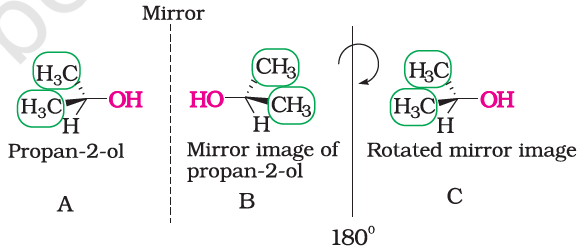
Figure : B is a mirror image of A; B is rotated by 180∘ and C is obtained; C is superimposable on A.
Similarly, ab agar hum butan-2-ol compound consider kare toh isme ek asymmetric carbon present hai, matlab ye molecule ek chiral molecule hai. Isko confirm karne ke liye hum pehle iss compound ka 3-dimensional structure consider karte hai (D), similarly iski mirror image structure (E) represent kar raha hai. Superimposability of (E) over (D) ko check karne ke liye hum structure (E) ko 180∘ par rotate iss tarah karte hai jis se structure (F) meh jo C−OH bond hai wo structure (D) ke C−OH ke jaise hi dikhe. Ab agar hum structure (D) aur (F) ko check kare toh dono structures ek dusre par superimpose nahi kar rahe hai jis wajah se hum kah sakte hai ki butan-2-ol ek chiral molecule hai.

Figure : E is a mirror image of D; E is rotated by 180∘ to get F and F is non superimposable on its mirror image D.
Similar observation hum chiral molecules jaise 2-chlorobutane, 2,3-dihydroxypropanal, 2-bromopropanoic acid etc., meh dekh sakte hai.
Enantiomers
Ab wo stereoisomers jo ek dusre ki non-superimposable mirror image hoti hai unko hum enantiomers bolte hai. For example butan-2-ol molecule ke structure (D) aur (F), ye dono ek dusre ke mirror images par superimpose nahi ho rahe hai isliye ye yahan enantiomeric pairs hai. Enantiomeric compounds generally identical physical properties : jaise melting point, boiling point, refractive index etc., show karte hai. Inn compounds ki sirf plane polarized light ki rotation different hoti hai. Ek isomer agar dextro rotatory hai, toh dusra isomer laevo rotatory hoga.
Racemic mixture and Racemisation
Jis mixture meh 2 enantiomers equal proportion meh present hote hai unko hum racemic mixture or racemic modification bolte hai aur iss mixture ki optical rotation zero hoti hai, kyunki ek isomer ki rotation dusre isomer ki rotation ko cancel kar deti hai. Racemic mixture ko hum compound ke naam ke aage dl or (±) se represent karte hai. For example (±) butan-2-ol, similarly enantiomer ka racemic mixture meh conversion ke process ko hum racemisation bolte hai.
Retention
Jab kabhi bhi ek chiral molecule ki chemical reaction hoti hai, tab product ki configuration reactant ke comparison same or opposite dono ho sakti hai. Agar chiral molecule ke asymmetric centre ki relative arrangement of bonds, reaction se pehle aur reaction ke baad same rahe tab wo reaction retention of configuration ke sath hoti hai. For example

In general, iss reaction meh asymmetric centre se koi bond break nahi hota hai, iss wajah se ye reaction retention of configuration ke sath product deti hai, although above example meh optical rotation ka sign (−) se (+) meh change ho raha hai.
Outcomes of a Reaction : Inversion, Retention and Racemisation
Jab asymmetric carbon atom ki chemical reaction hoti hai tab kuch bonds break hote hai aur kuch bonds form hote hai, jiske basis par overall hamare paas 3 different products bante hai.
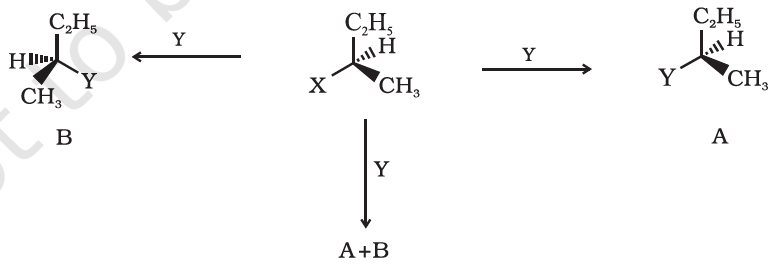
(i) Agar chemical reaction sirf A product deti hai tab iss process ko hum retention of configuration bolte hai, kyunki yahan reactant aur product A ki configuration same hoti hai.
(ii) Agar chemical reaction sirf B product deti hai tab iss process ko hum inversion of configuration bolte hai, kyunki yahan reactant aur product B ki configuration opposite hoti hai.
(iii) Agar chemical reaction ka product equimolar mixture of A aur B hota hai, tab iss process ko hum racemisation bolte hai aur jo product banta hai wo optically inactive hota hai, kyunki isme ek isomer plane polarized light ko dusre isomer ki respect meh opposite direction meh rotate karta hai.
Stereochemical Aspects of Nucleophilic Substitution Reactions
(a) Stereochemical aspects of SN2 reaction
So jaise ki humne padha hai ki SN2 reaction meh nucleophile OH− ka attack alkyl halide compound ke carbon atom par carbon-halogen bond ke opposite side se hota hai. Jis wajah se hume jo optically active product milta hai wo inversion of configuration ke sath milta hai matlab hamare reactant ki jo configuration hoti hai, product meh hume uski opposite configuration milti hai. Jisse hum walden inversion bhi bolte hai. For example (−)-2-bromooctane jab aqueous KOH solution ke sath react karta hai tab ye hume (+)-octan-2-ol as product deta hai.

(b) Stereochemical aspects of SN1 reaction
Ab agar hum SN1 reaction consider kare toh iss reaction meh optically active alkyl halide hume racemic mixture product deta hai. Kyunki iss reaction meh sp2 hybridised carbocation (planar) intermediate ka generation hota hai jo iss reaction ka slowest step hota hai. Iss wajah se iss reaction meh nucleophile OH− back aur front dono side se easily attack kar sakta hai jo hume mixture of enantiomers product deta hai. Iss enantiomeric mixture ke ek product meh hume reactant ke comparison same configuration milti aur dusre product meh reactant ke comparison opposite configuration milti hai. As a result, hume 50:50 enantiomeric mixture product milta hai. Therefore, iss reaction se hume ek racemic mixture (±) milta hai jo optically inactive hota hai. For example hydrolysis of optically active 2-bromobutane results in the formation of racemic mixture

Nucleophilic Substitution Intramolecular, SNi, (Darzon’s Process) :
Iss reaction meh part of the leaving group, jo substrate ko attack karta hai, wo khud hi rest of the leaving group se detach ho jata hai.
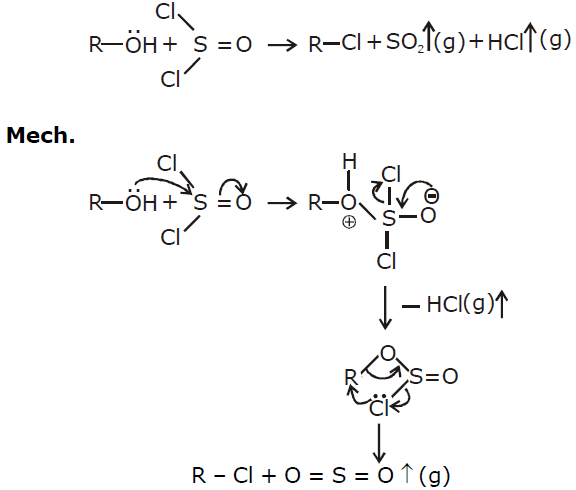
Note : Iss reaction meh retention of configuration hoti hai. Ye reaction pyridine ki absence meh hoti hai lekin agar yahan pyridine present hoga toh ye reaction SN2 mechanism follow karegi.
SNNGP (Neighbouring Group Participation) :
Iss reaction meh internal nucleophile present hona chahiye and internal nucleophile leaving group (lg) ke anti hona chahiye.
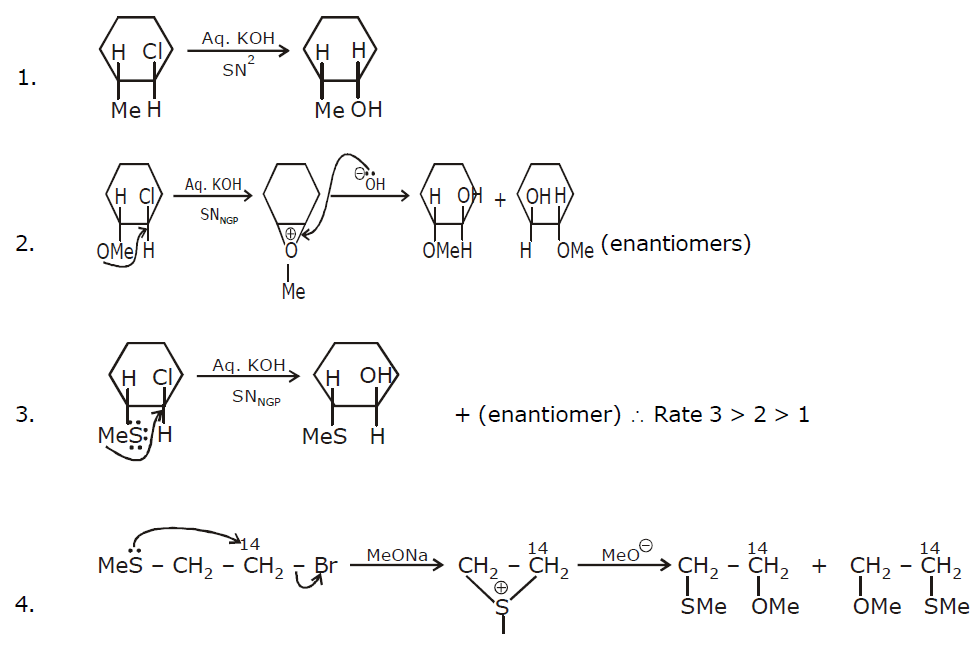
Nucleophilicity
Ab hum reference alkyl halide ki halogen-bearing carbon atom par nucleophilicity ko relative rate of substitution reactions se relate karte hai. Most reactive nucleophile more nucleophilic hote hai than less reactive members of the group. Kuch common Nu: reactants ki nucleophilicities ka variation below shown hai.
Nucleophilicity :

Increasing Nucleophile Strength
The cumulative results of studies of this kind has led to useful empirical remarks pertaining to nucleophilicity.
(i) Kisi bhi given element ke liye, negatively charged species more nucleophilic (and basic) hoti hai than equivalent neutral species.
(ii) Periodic table ke kisi bhi given period meh, nucleophilicity (and basicity) left to right move karne par decrease karti hai.
(iii) Periodic table ke kisi bhi given group meh, nucleophilicity top to bottom (i.e. with increasing size) move karne par increase karti hai, although hydrogen bonding ki wajah se solvent dependence hoti hai. Basicity, opposite manner meh vary karti hai.
Solvent Effects :
Solvation of nucleophlilic anions markedly influences their reactivity. Polar, aprotic solvents jaise DMSO (dimethyl sulfoxide), DMF (dimethylformamide) and acetonitrile, anions ko solvate nahi karte as well as methanol, but ye accompanying cations ko good solvation provide karte hai. Consequently, most of the nucleophiles jo above discuss kare gaya hai wo solutions meh jo inn solvents se prepare hote hai, more rapidly react karte hai. Ye solvent effects small basic anions ke liye more pronounced hote hai than for large weakly basic anions. Thus, DMSO solution meh koi bhi reaction following reactivity order meh observe kara jata hai :
Nucleophilicity :

Hello Points!
Formation of Higher Alkynes
When haloalkane is treated with sodium salt of alkynes (sodium alkynides), the halogen atom is replaced by alkynyl group (—C≡C—) to form higher alkynes.

The sodium alkynides needed for the above reaction are formed by the reaction of sodamide (or sodium in liquid NH3) with alkynes containing terminal triple bond.

Free Energy Diagram of Nucleophilic Substitution Reaction :
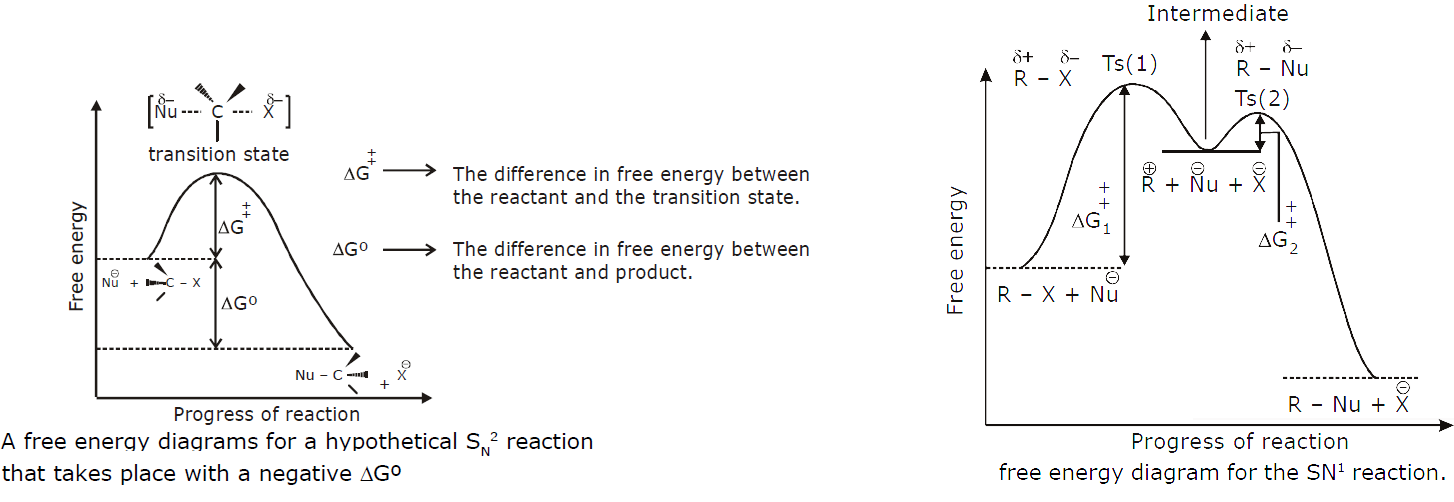
Chemical Reactions of Haloalkanes
Haloalkanes are one of the most reactive classes of organic compounds. These can be used for the preparation of a large variety of useful organic compounds. Some of the reactions of alkyl halides are given below :
1) Nucleophilic Substitution Reactions
2) Elimination Reactions
3) Reactions with Metals
Nucleophilic Substitution Reaction
In haloalkanes, the carbon is bonded to a halogen atom (X=F,Cl,Br,I) which is more electronegative than carbon. Consequently, the C−X bond is polar in nature. As a result, carbon gets partial positive charge (δ+) and the halogen atom gets partial negative charge (δ−). The polar nature of alkyl halides makes them highly reactive molecules.

The presence of partial positive charge on the carbon atom makes it susceptible to attack by electron rich groups (called nucleophiles). When a nucleophile stronger than the halide ion approaches the positively charged carbon atom of an alkyl halide, the halogen atom along with its bonding electron pair gets displaced and a new bond with the carbon and the nucleophile is formed. These reactions in which a stronger nucleophile displaces a weaker nucleophile are called nucleophilic substitution reactions.


In these reactions, the atom or group of atoms which loses its bond to carbon and takes on an additional pair of electrons is called a leaving group. Halide ions are good leaving groups. Better the leaving group, the faster is the nucleophilic substitution reaction. Among the alkyl halides, the leaving group ability increases along the series from fluoride to iodide as :
Groups like cyanides and nitrites possess two nucleophilic centres and are called ambident nucleophiles. Actually
(i) Cyanide group(CN−) is a hybrid of two contributing structures and therefore can act as a nucleophile in two different ways, i.e., linking through carbon atom resulting in alkyl cyanides R−CN and through nitrogen atom leading to isocyanides R−NC.
(ii) Similarly nitrite ion (NO2) also represents an ambident nucleophile with two different points of linkage. The linkage through oxygen results in alkyl nitrites R−O−N=O while through nitrogen atom, it leads to nitroalkanes. R−NO2
Types of Nucleophilic Substitution Reaction
The nucleophilic substitution reactions of alkyl halides have been found to proceed in the following two types of mechanisms :
(i) Substitution Nucleophilic Bimolecular, SN2
(ii) Substitution Nucleophilic Unimolecular, SN1
(i) Substitution Nucleophilic Bimolecular, (SN2)
The reaction between methyl bromide (CH3Br) and hydroxide ion (OH−) to form methanol follows a second order kinetics i.e., rate depends upon the concentrations of both reactants (alkyl halide and hydroxide ion).
The rate of the reaction may be expressed as,
In fact, methyl or primary alkyl halides follow this type of mechanism and it may, in general, be written as :
This reaction is called as nucleophilic substitution bimolecular because two molecules take part in determining the rate of the reaction. It is written as SN2, short form for substitution nucleophilic bimolecular. This type of reaction occurs in a single (concerted) step through the formation of a transition state.
In this mechanism, the nucleophile, OH− attacks the partially positively charged carbon atom of carbon halogen bond from the direction 180∘ away from the halogen atom i.e., from the backside. This leads to a transition state with a partially formed C....OH bond and a partially broken C….Cl bond. This process is said to be a one step reaction. In the transition state, the negative charge is shared by both the incoming nucleophile as well as outgoing chloride. Hydroxide has diminished negative charge because it has begun to share its electrons with carbon while chlorine has developed partial negative charge because it has partly removed a pair of electrons from carbon. Therefore, both OH and Cl have partial negative charge i.e., δ−. The remaining three bonds to carbon in the transition state adopt a planar arrangement. This arrangement may be described as the C−H bonds are arranged like the spokes of a wheel with C−OH and C−Cl bonds lying along the axis. The transition state is unstable because the carbon atom is simultaneously bonded to five atoms and therefore changes to products in which chloride ion leaves forming a C−OH bond. This reaction is shown below :

It is clear from the above one step mechanism, that the formation of transition state is rate determining step and therefore, the rate of the reaction depends upon the concentration of both alkyl halide and OH− Hence, it is a second order reaction or a bimolecular reaction.
Reactivity of alkyl halides towards SN2 reaction
The reactivity of alkyl halides towards SN2 mechanism has been found to be in the following order :
This can be easily explained on the basis of formation and stability of transition state in the reaction. Since the reaction requires the approach of the nucleophile to the carbon bearing the leaving group, the presence of bulky substituents on or near the carbon hinders the attack of nucleophiles and therefore, slows the reaction. This interference of the bulky groups with a reaction is called steric hindrance. Therefore, of the simple alkyl halides, methyl halide react most rapidly in SN2 reaction because there are only three small hydrogen atoms (least steric hindrance). On the other hand, tertiary alkyl halides are least reactive because of the presence of three bulky groups on carbon (maximum steric hindrance). Thus, the order of reactivity is

Figure : Steric effects in SN2 reaction. The relative rate of SN2 reaction is given in parenthesis.
(ii) Substitution Nucleophilic Unimolecular, (SN1)
The reaction between tert-butyl bromide and hydroxide ion to form tert-butyl alcohol follows first order kinetics i.e., the rate depends on the concentration of one reactant only. It has been observed that rate of reaction depends only on the concentration of alkyl halide.

The rate of reaction may be expressed :
or Rate=k[RX]
This reaction is called as substitution nucleophilic unimolecular because only one molecule is involved in determining the rate of the reaction and is written as SN1 reaction. Such types of reactions are generally carried out in polar protic solvents such as water, alcohol, acetic acid, etc. The SN1 mechanism occurs in two steps.

The first step is slow and reversible. It involves the cleavage of C−Br bond for which energy is obtained through solvation of bromide (halide) ion with the proton of the protic solvent. Since the slowest step is the rate determining step, the rate of reaction depends only on the concentration of tert-butyl bromide (alkyl halide). Hence, it is a first order or unimolecular reaction.
Reactivity of Alkyl Halides towards SN1 reaction
The order of reactivity depends upon the stability of carbocation in the first step. Greater the stability of the carbocation, greater will be its ease of formation from alkyl halide and hence faster will be the rate of the reaction. As we know 3∘ carbocation is most stable, therefore, the tert-alkyl halide will undergo SN1 reaction very fast. The order of reactivity will be :
For the same reasons, allylic and benzylic halides show high reactivity towards the SN1 reaction. The carbocation thus formed gets stabilised through resonance as shown below :

Comparison of Rate of Reactivity of SN1 and SN2 reaction :

Stereochemical Aspects of Nucleophilic Substitution Reactions
Stereochemistry plays a significant role in understanding the mechanisms of nucleophilic substitution reactions. For example a SN2 reaction proceeds with complete stereochemical inversion of configuration while SN1 reaction proceeds with racemisation. To understand these concepts, let us study some basic stereochemical principles and the terms commonly used.
(i) Optical Activity
When the solutions of certain organic compounds (such as sugar, camphor) are placed in the path of a plane polarised light, they rotate the path of the plane polarised light either to the left or to the right direction. Not all the organic substances rotate the plane polarised light. The substances which rotate the plane polarised light are called optically active substances. A substance which rotates the plane of polarised light to the right is called dextro-rotatory (Latin, dexter = right). Such compounds are designated as d− or by the sign (+).
A substance which rotates the plane of polarised light towards the left is called laevo-rotatory (Latin. laevous-left). Such compounds are designated as l− or by the sign (−). The common examples are lactic acid, tartaric acid, glucose, fructose, etc. The direction and magnitude of the rotation of the plane of the polarised light by a substance is measured with the help of an instrument called polarimeter.
The substances which do not rotate the plane of the polarised light are called optically inactive substances.
This property of a substance to rotate the plane of polarised light towards right or towards left is called optical activity.
Such (+) and (−) isomers of a compound are called optical isomer and the phenomenon is termed as optical isomerism.
(ii) Molecular Asymmetry, Chirality and Enantiomers
It has been observed that crystals of certain substances such as sodium ammonium tartrate exist in two forms which are mirror images. This observation laid the foundation of modern stereochemistry. It is demonstrated that aqueous solution of both types of crystals showed optical rotation, equal in magnitude (for solution of same concentration) but opposite in direction. It is attributed this difference in optical activity to the three dimensional arrangement of atoms called configurations in two of crystals. Later on, it has been observed the four valencies of carbon atom are directed towards the corners of a regular tetrahedron and if all the atoms or groups attached to a carbon atom are different, then such a carbon atom is called asymmetric carbon atom or stereocenter. The molecule containing asymmetric carbon would lack symmetry and is called asymmetric molecule. This asymmetry of the molecule is responsible for optical activity in compounds. Thus,
All objects or molecules have mirror images.
An object or a molecule which is not superimposable on its mirror image is called chiral.
The most common example of a chiral object is the human hand. If we hold our left hand in front of a mirror, the image looks like the right hand. If we try to superimpose left and right hands (both palms down), we observe that the hands cannot be superimposed. Therefore, hands are chiral. Similarly, gloves, shoes, etc., are chiral objects. The general property of handedness is called chirality. On the other hand, a cup, fork, glass tumbler, spoon, sphere, a cube or a cone are identical with their mirror images. Therefore, these can be superimposed on their mirror images. Such objects which are superimposable on their mirror images are called achiral. Thus,
Chiral object has non-superimposable mirror image
Achiral object has superimposable mirror image.

Figure : Some common examples of chiral and achiral objects
The same principle of right and left handedness can apply to organic molecules. Therefore,
The molecules which are not superimposable on their mirror images are called chiral molecules. The property of non-superimposability of a structure on its mirror image is called chirality.
Similarly, molecules which are superimposable on their mirror images are called achiral molecules.
Generally chiral molecules are optically active and achiral molecules are optically inactive compounds.
Let us test the superimposability of two simple molecules propan-2-ol and butan-2-ol.
As is evident, propan-2-ol does not contain an asymmetric carbon, because all the four atoms or groups attached to carbon are not different. Therefore, it is an achiral molecule. Let us confirm it by the superimposability test. The three dimensional structure of propan-2-ol is shown as (A) and its mirror image is shown as (B). To check the superimposability of (B) over (A), rotate (B) through 180∘ in such a way that the C−OH bond in the new structure (C) projects in the same direction as that in the structure (A). Now check structures (A) and (C). We find that (A) and (C) are superimposable. Hence, propan-2-ol is an achiral molecule.

Figure : B is a mirror image of A; B is rotated by 180∘ and C is obtained; C is superimposable on A.
Now consider butan-2-ol. It contains one asymmetric carbon atom and therefore, it is expected to be a chiral molecule. Let us confirm it by a superimposability test. The three dimensional structure of butan-2-ol is shown as (D). Its mirror image is shown in structure (E). Now rotate (E) through 180∘ in such a way that the C−OH bond in the new structure (F) projects in the same direction as that in the structure (D). Now try to superimpose (F) over (D). We observe that (D) and (F) are non-superimposable no matter how we turn or twist the molecule without breaking the bonds. As shown in Figure, OH and H can be superimposed but the spatial orientation of CH3, and C2H5, are different. Therefore, butan-2-ol is a chiral molecule.

Figure : E is a mirror image of D; E is rotated by 180∘ to get F and F is non superimposable on its mirror image D.
Similar observation observed in chiral molecules like 2-chlorobutane, 2,3-dihydroxypropanal, 2-bromopropanoic acid etc.,
Enantiomers
The stereoisomers related to each other as non-superimposable mirror images are called enantiomers. For example butan-2-ol molecule structure (D) and (F) in above figure are enantiomers. Enantiomers possess identical physical properties namely, melting point, boiling point, refractive index etc., they only differ with respect to the rotation of plane polarized light. If one of the enantiomer is dextro-rotatory, the other will be laevo-rotatory.
Racemic mixture and Racemisation
A mixture containing two enantiomers in equal proportions will have zero optical rotation, as the rotation due to the one isomer will be cancelled by the rotation due to the other isomer. Such a mixture is known as racemic mixture or racemic modification. A racemic mixture is represented by prefixing dl or (±) before the name, for example (±) butan-2-ol. The process of conversion of enantiomers into racemic mixture is known as racemisation.
Retention
Whenever a chemical reaction is carried out on a chiral molecule, the product may have the same configuration as the reactant or may have the opposite configuration. If the relative spatial arrangement of bonds at an asymmetric centre in a chiral molecule remains the same before and after the reaction, the reaction is said to occur with retention of configuration. In other words, retention of configuration means the preservation of integrity of the spatial arrangement of bonds at an asymmetric centre during a chemical reaction or transformation. For example

During the reaction, no bond at the asymmetric centre is broken, therefore, the reaction proceeds with retention of configuration even though the sign of optical rotation has changed from (−) to (+).
Outcomes of a Reaction : Inversion, Retention and Racemisation
When a chemical reaction involves bond cleavage or bond formation at an asymmetric carbon atom, three different products may be formed. For example, during the substitution of a group X by Y in the following reaction, the three possible products may be shown below:

In this case
(i) If A is the only product, the process is called retention of configuration because A has the same configuration as the starting reactant.
(ii) If B is the only product, the process is called inversion of configuration because B has the configuration opposite to the starting reactant.
(iii) If an equimolar mixture of A and B (i.e, a 50:50 mixture) is formed, then the process is called racemisation and the product is optically inactive because one isomer will rotate light in the direction opposite to another.
Stereochemical Aspects of Nucleophilic Substitution Reactions
(a) Stereochemical aspects of SN2 reaction
In SN2 reaction, the attack of nucleophile OH− occurs at the rear side of the molecule relative to the halogen atom. In other words, −OH group has not taken the position previously occupied by the halogen atom but on the side opposite to one where the halogen atom is present. As a result SN2 reaction are accompanied by inversion of configuration as an umbrella is turned inside out in a strong wind. This process is called inversion of configuration or Walden inversion. Thus, in case of optically active alkyl halide, the product obtained has an inversion of configuration i.e., there is change in sign of rotation from (+) to (−) and vice versa. For example (−)-2-bromooctane on treatment with aqueous KOH solution gives (+)-octan-2-ol as the product.

(b) Stereochemical aspects of SN1 reaction
In case of optically active alkyl halide, the product obtained during SN1 reaction is a racemic mixture. This is because the intermediate carbocation formed in the slow step is planar (achiral) species. Therefore, the attack of the nucleophile, OH− ion can take place with equal case from both the faces (front and rear) forming a mixture of two enantiomers. In one enantiomer, the nucleophile occupies the same position as originally occupied by the halogen atom while in the other enantiomer the nucleophile occupies the position opposite to that of the halogen atom. As a result, 50:50 mixture of the two enantiomers (laevo and dextro) is formed. Therefore, the product formed is a racemic mixture (±) which is optically inactive. Thus, SN1 reactions of optically active alkyl halides are accompanied by racemisation. For example, hydrolysis of optically active 2-bromobutane results in the formation of racemic mixture

Nucleophilic Substitution Intramolecular, SNi, (Darzon’s Process) :
In this reaction, the part of the leaving group which attacks the substrate detaches itself from the rest of the leaving group.

Note : In SNi retention of configuration takes place. In presence of pyridine above reaction follow the SN2 reaction mechanism.
SNNGP (Neighbouring Group Participation) :
Increase in rate of substitution nucleophilic reaction due to attack of internal nucleophie is called as SNNGP is also known as Anchimeric assistence. In this reaction, internal nucleophile must be present and internal nucleophile must be anti to leaving group (lg).

Nucleophilicity
Nucleophilicity is thereby related to the relative rate of substitution reactions at the halogen-bearing carbon atom of the reference alkyl halide. The most reactive nucleophiles are said to be more nucleophilic than less reactive members of the group. The nucleophilicities of some common Nu: reactants vary as shown in the following.
Nucleophilicity :

Increasing Nucleophile Strength
The cumulative results of studies of this kind has led to useful empirical remarks pertaining to nucleophilicity.
(i) For a given element, negatively charged species are more nucleophilic (and basic) than equivalent neutral species.
(ii) For a given period of the periodic table, nucleophilicity (and basicity) decreases on moving from left to right.
(iii) For a given group of the periodic table, nucleophilicity increases from top to bottom (i.e. with increasing size), although there is a solvent dependence due to hydrogen bonding. Basicity varies in the opposite manner.
Solvent Effects :
Solvation of nucleophlilic anions markedly influences their reactivity. Polar, aprotic solvents such as DMSO (dimethyl sulfoxide), DMF (dimethylformamide) and acetonitrile do not solvate anions nearly as well as methanol, but provide good solvation of the accompanying cations. Consequently, most of the nucleophiles discussed here react more rapidly in solutions prepared from these solvents. These solvent effects are more pronounced for small basic anions than for large weakly basic anions. Thus, for reaction in DMSO solution we observe the following reactivity order :
Nucleophilicity :

EXAMPLE 5
Explain the SN1 reaction mechanism of the following by equations only.
OH |CH3−CH−CH−CH3−HOHHydrolysis−−−−−→CH3−CH2−C−CH3 | | | Br CH3 CH32-Bromo-3-methylbutane 2-Methylbutan-2-ol

EXAMPLE 6
Hello Points!
Haloalkanes give cyanides with KCN and isocyanides with AgCN as the product.
The cyanide ion is a resonance hybrid of the following structures :
The resonating structures show that cyanide ion can attack the nucleophilic site through C as well as through N. Such a nucleophile which is capable of attacking through more than one atom (site) is called ambident nucleophile.
Thus, CN− behaves as an ambident nucleophile. KCN (or NaCN) is predominantly ionic and therefore, both C and N atoms are free to donate electron pair. Since, C—C bond is relatively stronger than C—N bond, therefore, the attack occurs mostly through the carbon atom of the cyanide group forming alkyl cyanides as the major product.

On the other hand, AgCN is predominantly covalent. Therefore, in this case only N-atom is free to donate electron pair and the attack mostly occurs through the N-atom of the cyanide group forming alkyl isocyanides as the major product.

Thus,

Similarly haloalkanes give alkyl nitrite with KNO2 and nitroalkanes with AgNO2 as the product.
Nitrite ion (−O−N=O) like cyanide ion is an ambident nucleophile because it has two sites (oxygen or nitrogen) through which it can attack the alkyl halide. Attack through nitrogen gives nitro compounds and attack through oxygen gives nitrites.
Alkali metal nitrites (KNO2) are ionic compounds and the bond between K−O is ionic and therefore, the negative charge on oxygen is the attacking site. Hence, the attack of oxygen end on alkyl halide forms alkyl nitrites (R−O−N=O).

On the other hand, silver nitrite (AgNO2) is a covalent compound and the bond between Ag−O is covalent. Therefore, it does not have a negative charge on the oxygen atom. Hence, the nucleophilic attack occurs through the lone pair on nitrogen forming nitroalkanes (R−NO2).

Elimination Reactions
Elimination reaction mein two atoms or groups (YZ) substrate se remove ho kar π bond form karte hain.

Reagents and conditions ke basis par elimination reaction either first order (E1) or second order (E2) ho sakti hai.
(i) Eliminiation Unimolecular Reaction (E1)

(a) Ye reaction unimolecular hoti hai aur ye two step meh hoti hai.
(b) Ye reaction first order kinetics follow karti hai.
(c) Iss reaction meh intermediate carbocation hota hai, so yahan rearrangement of carbocation ho sakta hai.
(d) Iss reaction ke second step meh ek base proton ko abstract karta hai from the carbon atom adjacent to the carbocation, aur tab ye alkene form karta hai.
(e) Kinetics → Rate ∝ [Substrate]
Thus, Rate =k [Substrate]
(ii) Eliminiation Bimolecular Reaction (E2)

(a) Ye reaction bimolecular hoti hai aur ye second order kinetics follow karti hai.
(b) Ye ek single step reaction hai.
(c) Iss reaction meh jab base adjacent carbon se proton abstract karta hai tab yahan leaving group bahar nikalta hai.
(d) Rate of this reaction, transition state stability as well as leaving group tendency par depend karta hai.
(e) Ye reaction elemental as well as kinetic isotopic effect show karti hai with lg as well as at β−position.
(f) Iss reaction meh transition state form hoti hai so yahan koi rearrangement possible nahi hoti.
(g) Iss reaction meh proton aur leaving group ki orientation ek dusre ke antiperiplanar honi chahiye.
Dehydrohalogenation Reaction :
Jab hum haloalkane compounds jisme β-hydrogen present hota hai usko alcoholic solution of potassium hydroxide ke sath boil karte hai, tab iss reaction meh hydrogen halide ka elimination (HX) hota hai jo hume alkene as product deta hai. For example

Iss reaction meh hydrogen β-carbon se aur halogen α-carbon atom se eliminate hota hai. Ab kyunki hydrogen β-position se eliminate hota hai isliye iss reaction ko hum β-elimination reaction bolte hai aur kyunki iss reaction meh overall hydrogen halide ka elimination hota hai isliye ye reaction dehydrohalogenation reaction ka example hota hai. Iski agar hum general reaction consider kare :
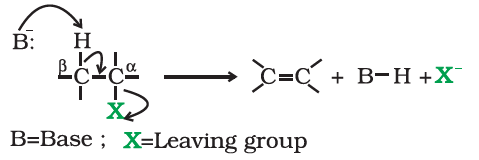
Lekin iss reaction ke kuch cases meh hume 2 ya 2 se jyada products ke mixture milne ki bhi possibility hoti hai. Ab haloalkanes ke case meh hydrogen halide ka elimination 2 different ways meh ho sakta hai, so isme wo alkene humara major product banta hai jisme double bond carbon atoms maximum alkylated hote hai. Iss rule ko hum Saytzeff’s Rule bolte hai. For example

Ease of Dehydrohalogenation
According to Saytzeff’s rule, jo alkene jitne jyada alkyl groups se substituted hota hai wo utna hi most preferred product hota hai kyunki iss case meh ye alkene dusre alkene ki respect meh more more faster form hota hai. Agar hum ease of formation of alkene consider kare
Ab alkene ki stability ka order ease of formation of alkene ko follow karta hai jiske according hum kah sakte hai, more stable the alkene, the faster it is formed.
Similarly agar hum alkyl halide consider kare so iss case meh jo alkyl halide jitna jyada substituted alkene generate kar raha hai wo dehydrohalogenation reaction utna hi easily or fast de raha hai. For example agar hum bromoethane (1∘), 2-bromopropane (2∘) aur 2-methyl-2-bromopropane (3∘) consider kare so iss case meh
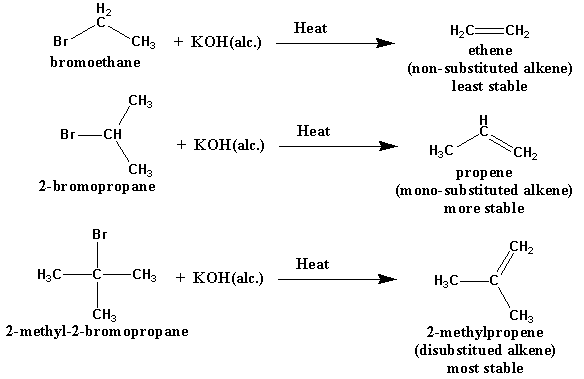
Iss reaction ke basis par hum kah sakte hai ki inn teeno alkyl halides compounds ka ease of dehydrohalogenation ka following order hoga
In general, agar hum haloalkanes compounds ki elimination reaction meh reactivity order consider kare, tab iska following order hota hai.
Dehalogenation Reactions :
Jab both leaving atoms halogens ho tab iss type ke elimination reaction ko hum dehalogenation reactions kahte hai.
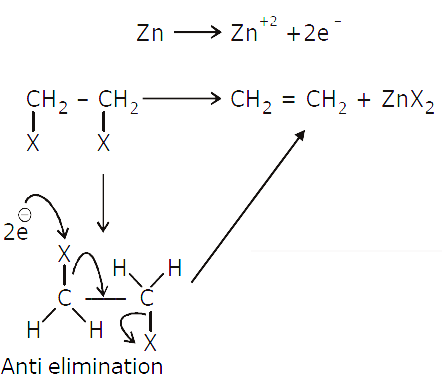
Unimolecular Conjugate Base Reaction (E1CB) :
Iss reaction meh, substrate se pehle Hydrogen (H) atom leave karta hai uske baad halogen (X) atom leave karta hai. Ye reaction two steps meh complete hoti hai aur isme carbanion as an intermediate form hota hai.
Step 1 : Consists of the removal of a proton, H+ by a base generating a carbanion.

Step 2 : Carbanion loses a leaving group to form alkene.

E1CB reaction hone ke liye substrate ke pass acidic hydrogen and poor leaving group hona chahiye.
Corresponding example are shown below :

Intramolecular or Cyclic Elimination Mechanism (Ec or Ei) :
Iss reaction mein, leaving group aur base same molecule meh present hote hai. Iss reaction meh, transition state cyclic molecule hota hai. Overall, yeh reaction syn elimination hai. Iss reaction meh major product Hoffmann product hota hai as it is obtain by least hindered site/cyclic transition state.
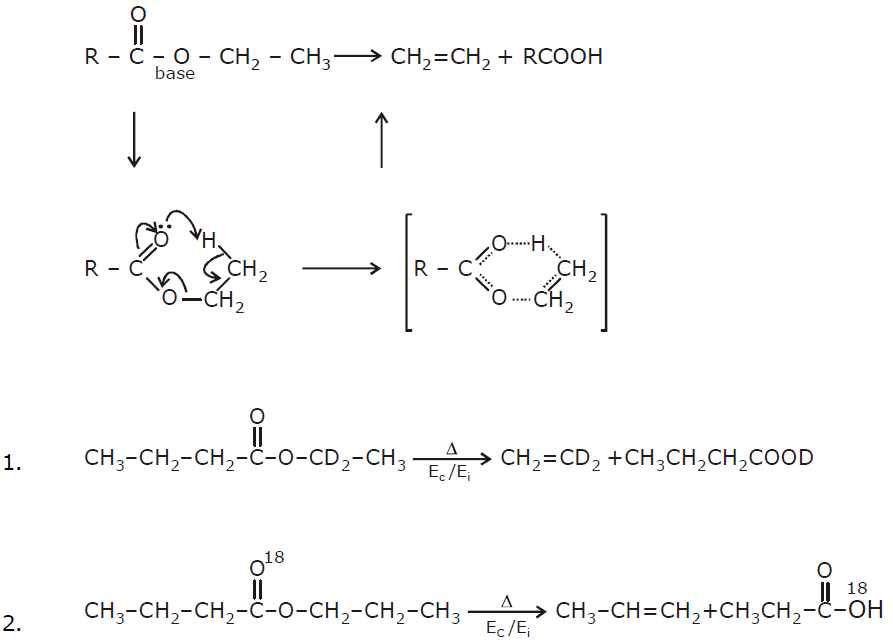
Dehydration of Alcohols
Dehydration of alcohol, elimination reaction ka other example hota hai. Jab acids jaise conc. H2SO4 or H3PO4 ko as a dehydrating agent use kara jata hai toh, E1 mechanism follow hota hai. Ab acid, jo proton deta hai iss proton ko alcohol accept kar leta hai.

Ab protonated alcohol water molecule lose karta hai aur carbocation form hota hai.

Carbocation proton lose karta hai to form alkene.

Dehydration ka matlab alcohol se H2O ka removal hona hai. E.g.,

Jab more than one alkene form ho sakti hai, tab E1 reaction mechanism se predominantly, more substituted alkene as a more stable alkene (Saytzeff's rule) form hoti hai.

Dehydration of alcohols is in the order :
Elimination Reactions
In an elimination reaction two atoms or groups (YZ) are removed from the substrate with formation of π bond.

Depending on the reagents and conditions involved, an elimination may be a first order (E1) or second order (E2).
(i) Eliminiation Unimolecular Reaction (E1)

(a) It is unimolecular, two step process.
(b) It is first order reaction.
(c) Reaction intermediate is carbocation, so rearrangement is possible.
(d) In the second step, a base abstracts a proton from the carbon atom adjacent to the carbocation, and forms alkene.
(e) Kinetics → Rate ∝ [Substrate]
Thus, Rate =k [Substrate]
(ii) Eliminiation Bimolecular Reaction (E2)

(a) It is bimolecular reaction, and follows second order kinetics.
(b) Leaving group leaves when base is taking proton from adjecent carbon.
(c) It is a single step reaction.
(d) Here, Rate of the reaction depends on the transition state stability as well as leaving group tendency.
(e) It shows elemental as well as kinetic isotopic effect with lg as well as at β−position.
(f) It is a transition state mechanism therefore rearrangement is not possible.
(g) The orientation of proton and leaving group should be antiperiplanar for E2 reaction.
Dehydrohalogenation Reaction:
When haloalkanes with β-hydrogen atom are boiled with alcoholic solution of potassium hydroxide, they undergo elimination of hydrogen halide (HX) resulting in the formation of alkenes.

These reactions are called β-elimination reactions because the hydrogen atom present at β-position of haloalkane (i.e., at the carbon atom next to that which carries the halogen) is removed. Such reactions are also called dehydrohalogenation (removal of hydrogen halide) reactions. The elimination reaction occurs by abstraction of proton from a carbon atom next to the carbon bearing halogen atom (called β-hydrogen) and a halide ion is also lost resulting a new π-bond as :

Many compounds can be eliminated in more than one way to give a mixture of products. In case a haloalkane can eliminate hydrogen halide in two different ways, then that alkene will be preferred in which carbon atoms joined by the double bond are maximum alkylated i.e., contain the largest number of alkyl groups. This rule is called Saytzeff's rule. For example

Ease of Dehydrohalogenation
According to Saytzeff's rule, the alkene with greater number of alkyl groups (the most substituted alkenes) is the preferred product during dehydrohalogenation of alkyl halide because it is formed faster than the other alkene.
Ease of formation of alkenes
The stability of alkenes follows the same sequence. Thus, we can say that the more stable the alkene, the faster it is formed. In the light of Saytzeff's rule, any alkyl halide which gives a more stable (i.e., more highly substituted) alkene must undergo dehydrohalogenation reaction faster than the one which gives a less stable (i.e., less highly substituted) alkene. For example consider the dehydrohalogenation of bromoethane (1∘), 2-bromopropane (2∘) and 2-methyl-2-bromopropane (3∘)

Thus, the ease of dehydrohalogenation of these three alkyl halides follows the order :
In general, the reactivity of haloalkanes towards elimination reaction i.e., ease of dehydrohalogenation follows the order:
Dehalogenation Reactions :
When both the leaving atoms are halogens then this type of elimination reaction is termed as dehalogenation reaction

Unimolecular Conjugate Base Reaction (E1CB) :
In this reaction, hydrogen leaves first and then the halogen. This is a two step process, the intermediate is a carbanion.
Step 1 : Consists of the removal of a proton, H+ by a base generating a carbanion.

Step 2 : Carbanion loses a leaving group to form alkene.

For the E1CB, substrate must be containing acidic hydrogens and poor leaving groups.
Corresponding example are shown below :

Intramolecular or Cyclic Elimination Mechanism (Ec or Ei) :
In this reaction, leaving group and base present in same molecule. It proceed by cyclic transition state. Overall it is syn elimination. Hoffmann product is major product as it is obtain by least hindered site/cyclic transition state.

Dehydration of Alcohols
Dehydration of alcohol is another example of elimination reaction. When acids like conc. H2SO4 or H3PO4 are used as dehydrating agents, the mechanism is E1. The proton given by acid is taken up by alcohol.

The protonated alcohol loses a water molecule and forms a carbocation.

The carbocation loses a proton to form alkene.

Dehydration is removal of H2O from alcohols. E.g.,

When more than one alkenes can be formed, a typical E1 reaction yields predominantly, the more substituted more stable alkene (Saytzeff's rule).

Dehydration of alcohols is in the order :
EXAMPLE 7
Hello Points!
Comparison of E1 and E2 Elimination Reactions :
Factors which effects Elimination Reactions and their Characteristics are as follows :

Energy Diagram of E1 and E2 Elimination Reactions :

EXAMPLE 8
2-Bromopentane is treated with alcoholic KOH solution. What is the major product formed in this reaction? What is the name of the reaction ?
The reaction is known as β-elimination and the major product is pent-2-ene according to Saytzeff's rule that is more substituted alkene is the major product.
Elimination versus Substitution
Alkyl halide compounds substitution aur elimination dono reaction show kar sakte hai. Jis reaction meh ek atom halide ion ko replace karta hai uss reaction ko hum substitution reaction bolte hai aur jis reaction meh halide ion dusre atom or ion jaise ki H+ ion ko bahar nikalta hai tab uss reaction ko hum elimination reaction bolte hai. Generally alkyl halide compounds ke case meh substitution (SN1orSN2) aur elimination reaction ke beech competition hota hai. Kyunki mostly bases, nucleophiles ki tarah bhi kaam karte hai iss wajah se ye substitution aur elimination dono reaction show kar sakte hai. Ab kaun si reaction kab hogi wo nature of alkyl halides, strength, size of base or nucleophile aur reaction conditions par depend karta hai. For example bulkier nucleophile ek base ki tarah kaam karta hai, jo further proton ko abstract kar elimination reaction show karta hai. Similarly normal nucleophile tetravalent carbon par attack kar substitution reaction show karta hai.
For example jab hum 2-bromopropane ko bulkier nucleophile jaise potassium tert-butoxide ke sath react karte hai tab ye elimination reaction ke basis par hume alkene product deta hai.
Similarly, jab hum smaller nucleophile OH− ke sath reaction karte hai tab ye substitution reaction ke basis par hume alcohol product deta hai.

Ab agar hum alkyl halide consider kare so isme primary alkyl halide compounds SN2 reaction show karte hai, kyunki primary carbocation jyada stable nahi hote. Lekin secondary alkyl halide compounds SN2 or elimination dono reaction show kar sakte hai aur ye strength of base or nucleophile par depend karta hai ki kaun si reaction kab hogi. Similarly, tertiary alkyl halide compounds SN1 or elimination dono reaction show kar sakte hai aur ye stability of carbocation aur more substituted alkene par depend karta ki kaun si reaction kab hogi.
In general, high temperature par elimination reaction hoti hai.
Elimination versus Substitution
Alkyl halides undergo substitution and elimination reactions. When another atom replaces the halide ion, the reaction is a substitution whereas when halide ion leaves with another atom or ion (often H), the reaction is an elimination. Substitution and elimination reactions often compete with each other. Most bases are also nucleophiles and therefore, can engage in substitution or elimination depending upon the alkyl halide and the reaction conditions. An alkyl halide with β-hydrogen atom when reacted with a base or a nucleophile has two competing routes, substitution (SN1orSN2) and elimination. Which route will be followed depends upon the nature of alkyl halide, strength and size of base or nucleophile and reaction conditions. For example, a bulkier nucleophile will prefer to act as a base and abstract a proton rather than approach a tetrahedral carbon because of steric hindrance and vice versa.
For example, when 2-bromopropane is treated with a bulkier nucleophile such as potassium tert-butoxide, elimination occurs to form an alkene.
On the other hand, when it is treated with a smaller nucleophile such as OH− ion, substitution occurs to form an alcohol as shown below :

Similarly, a primary alkyl halide will prefer SN2 reaction because primary carbocation are not very stable. On the other hand, a secondary alkyl halide can undergo SN2 or elimination reaction depending upon the strength of base or nucleophile while a tertiary alkyl halide may undergo SN1 or elimination depending upon the stability of carbocation or the more substituted alkene.
In general, elimination reactions require higher temperatures than substitution reactions.
Reaction with Active Metals
Jab hum most of organic chlorides, bromides, iodides compounds ko active metals ke sath react karte hai tab ye carbon-metal bonds containing compounds generate karte hain jinko hum organo-metallic compounds bolte hai.
(i) Action with Magnesium (formation of Grignard reagent) : Jab hum alkyl halide compound ko ether ki presence meh magnesium metal ke sath react karte hai tab ye hume alkyl magnesium halide compound deta hai jisko hum Grignard reagent bolte hai aur isko hum RMgX se represent karte hai.

Grignard reagent meh carbon-magnesium bond covalent ke sath highly polar hota hai, jisme Carbon electropositive metal Magnesium se electrons ko pull karta hai. Kyunki carbon (2.5) aur magnesium (1.2) ki beech large electronegativity difference hota hai. Iss reagent meh magnesium-halogen bond ionic nature show karta hai, iski agar hum general representation consider kare.

Grignard reagent reactive compounds hote hai, jab hum inko proton source compound ke sath react karte hai tab ye hume hydrocarbons compound deta hai. Ab agar hum weakly acidic compounds jaise water, alcohol, amines, tertiary alkynes etc., ke sath iski reaction kare tab ye hume hydrocarbon compound deta hai.

Iss reaction meh Z=OH,RO,NH2,RNH,RC≡C etc.,
Iss wajah se Grignard reagent ki preparation ke time hume traces of moisture ko bhi avoid karna hota hai. Iss wajah se yahan hum reaction ether meh perform karte hai. Grignard reagent oxygen aur carbon dioxide ke sath bhi react karta hai, isliye iss reagent ki preparation in the absence of air under inert atmosphere hoti hai.
(ii) Action with Sodium (Wurtz Reaction) : Jab alkyl halide ke 2 molecules in the presence of dry ether metallic sodium ke sath react karte hai tab ye alkanes product form karte hai. Iss reaction ko hum Wurtz Reaction bolte hai aur iss reaction ko hum symmetrical alkanes preparation ke liye use karte hai.
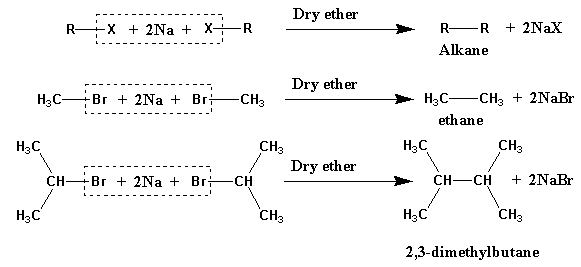
Ye reaction tertiary alkyl halide compounds show nahi karte, kyunki under basic reaction conditions tertiary halide compounds hume dehydrohalogenation reaction ke basis par alkene product dete hai.
Iss reaction ko jab hum 2 different alkyl halides reactants lekar karte hai, tab ye hume mixture of 3 alkane products deta hai. For example

Reaction with Active Metals
Most organic chlorides, bromides, iodides react with certain metals to give compounds containing carbon-metal bonds. Such compounds are known as organo-metallic compounds
(i) Action with Magnesium (formation of Grignard reagent) : When a solution of an alkyl halide in dry ether is treated with magnesium, an alkyl magnesium halide is formed. Alkyl magnesium halides, generally represented as RMgX, are an important class of organometallic compounds and are known as Grignard reagents.

In the Grignard reagent, the carbon-magnesium bond is covalent but highly polar with Carbon pulling electrons from electropositive Magnesium. This is because of the large electronegativity difference between carbon (2.5) and magnesium (1.21). The magnesium-halogen bond is essentially ionic. Thus, Grignard reagents may be represented as :

These Grignard reagents are very reactive compounds. They react with any source of proton to form hydrocarbons. Even weakly acidic compounds such as water, alcohol, amines, terminal alkynes, etc., react with Grignard reagent to give corresponding hydrocarbon.

where Z may be OH,RO,NH2,RNH,RC≡C, etc.
Therefore, it is very necessary to avoid even traces of moisture from a Grignard reagent during its preparation. That is why reaction is carried out in dry ether. These also react readily with oxygen and carbon dioxide. Therefore, these should be prepared and used in the absence of air under an inert atmosphere.
(ii) Action with Sodium : Two molecules of alkyl halides (same or different) react with metallic sodium in the presence of ether to form alkanes. This reaction is called Wurtz reaction and is used to prepare symmetrical alkanes.

This reaction generally fails with tertiary alkyl halides because under the basic conditions of the reaction, they prefer to undergo dehydrohalogenation to form alkenes.
When a mixture of 2 different alkyl halides are used, all the three possible alkanes are formed. For example

EXAMPLE 9
Why is it necessary to avoid even traces of moisture during the use of a Grignard reagent ?
Grignard reagent (RMgX) is highly reactive. Even in the presence of traces of water it gets hydrolysed to form a hydrocarbon (alkane). It is therefore, synthesised as well as used in completely anhydrous conditions. Normally completely anhydrous ether is used for this purpose
Chemical Properties of Haloarenes
Haloarene compounds nucleophilic substitution reaction ke liye in comparison to haloalkanes compounds less reactive hote hai. Ab aisa kyun hota hai :
(i) Resonance Effect : Haloarene compounds meh halogen atom par jo lone pair of electrons present hote hai, wo ring ke π electrons ke sath conjugation meh hote hai. Jiske agar hum resonance structures dekhe :

Inn resonance structures meh C−Cl bond ke beech partial double bond character generate hota hai. Jis wajah se iss bond ki cleavage difficult ho jati hai in comparison to haloalkane, iss wajah se ye compounds nucleophilic substitution reaction ke liye less reactive hote hai.
(ii) Difference in Hybridization of Carbon Atom in C−X bond : Haloalkanes compound ke C−X bond meh carbon ki hybridisation sp3 hoti hai aur haloarene compound ke C−X bond meh carbon ki hybridisation sp2 hoti hai. Ab kyunki sp2 hybridised carbon atom meh s-character jyada hota hai isliye ye jyada electronegative hota hai matlab ye electrons ko more tightly hold kar sakta hai in comparison to sp3 hybridised carbon jiske paas less s-character hota hai. Iske according haloarene compounds meh C−X bond ki length 169 pm aur haloalkane compounds meh C−X bond ki length 177 pm hoti hai aur iss shortening of bond length ki wajah se haloarene compound jyada stable hote hai matlab iski bond cleavage difficult hoti hai. Iss wajah se haloarene compound, haloalkane compound ke comparison nucleophilic substitution reaction ke liye less reactive hote hai.

(iii) Instability of Phenyl Carbocation : Haloarene compounds meh jo phenyl carbocation self ionisation ki wajah se generate hota hai wo resonance ke through stable nahi hota, kyunki sp2 hybridised orbital of carbon jiske paas positive charge hai wo p orbital of phenyl ring ke perpendicular hota hai. Iss wajah se phenyl carbocation generate nahi hota aur issi wajah se ye SN1 reaction show nahi karta.
(iv) Repulsion between the Electron Rich Attacking Nucleophiles and Electron Rich Arenes : Jaise ki hume pata hai arene ring electron rich species hoti hai, so jab electron rich nucleophile ispar attack karta hai tab dono electron rich species ke beech repulsion generate hoti hai jis wajah se ye reaction easily nahi ho paati. Iske according hum kah sakte hai haloarene compound, haloalkane compound ke comparison substitution reaction meh less reactive hote hai.
Chemical Properties of Haloarenes
Haloarenes are chemically less reactive than haloalkanes. The low reactivity of haloarenes in comparison to haloalkanes is due to the following reasons :
(i) Resonance Effect : In haloarenes, the electron pairs on the halogen atom are in conjugation with π-electron of the ring and the following resonating structures are possible :

As a result of resonance, there is delocalisation of electrons on C−Cl bond which acquires a partial double bond character. This is also evident from the contribution of structures. As a result, the bond cleavage in haloarenes is more difficult than haloalkanes in which carbon is attached to halogen by a pure single bond. Therefore, haloarenes are less reactive towards nucleophilic substitution reactions.
(ii) Difference in Hybridization of Carbon Atom in C−X bond : In haloalkanes, the carbon atom of the C−X bond is sp3 hybridised while in haloarenes, the carbon atom attached to halogen is sp2 hybridised. The sp2 hybridised carbon atom with greater s-character is more electronegative. It can hold the electron pair of the bond more tightly than the sp3 hybridised carbon atom in alkyl halides with less s-character. Therefore, the C−X bond in haloarenes is 169 pm shorter than in haloalkanes is 177 pm. The shortening of bond length imparts stability to aryl halides and as a result, the bond cleavage becomes rather difficult. Therefore, haloarenes are less reactive than haloalkanes towards nucleophilic substitutions.

(iii) Instability of Phenyl Carbocation : In case of haloarenes, the phenyl cation formed as a result of self ionisation will not be stabilised by resonance because the sp2 hybridised orbital of carbon having +ve charge is perpendicular to the p-orbital of the phenyl ring. Therefore, phenyl cation is not formed and therefore, SN1 mechanism cannot occur.
(iv) Repulsion between the Electron Rich Attacking Nucleophiles and Electron Rich Arenes : It is because of electron rich arenes, electron rich nucleophile will not approach closely for the attack because of repulsion. Thus, haloarenes are less reactive towards the substitution reactions than haloalkanes.
Chemical Reactions of Haloarenes
Haloarene compound substitution reaction generally drastic conditions meh show karte hai.
1) Nucleophilic Substitution Reaction
Replacement by Hydroxyl Group (formation of phenol)
Jab hum aryl halides ko aqueous solution of sodium hydroxide ke sath 623 K temperature aur 300 atm pressure par heat karte hai tab ye hume phenol product deta hai.

Effect of Substituents in Haloarenes (aryl halides) on the Reactivity :
Ab agar aryl halide compound meh ortho- and para- position par electron withdrawing group (−NO2) present ho tab aryl halide compound ki reactivity increase ho jati hai aur tab hume nucleophilic substitution reaction ke liye less drastic conditions apply karni hoti hai.
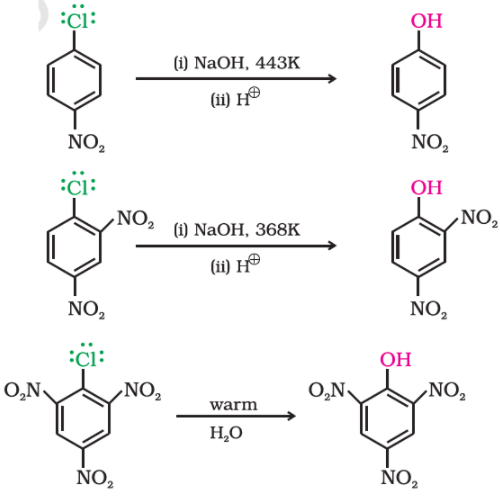
Explanation for effect of −NO2 (or EWG), group
Ab ye electron withdrawing groups ka effect ortho- aur para- positions par hota hai, iska meta-position par koi effect nahi hota isko samjhne ke liye sabse pehle hum o−,m− aur p−isomer ki nucleophilic substitution reaction with resonance structures consider karte hai.
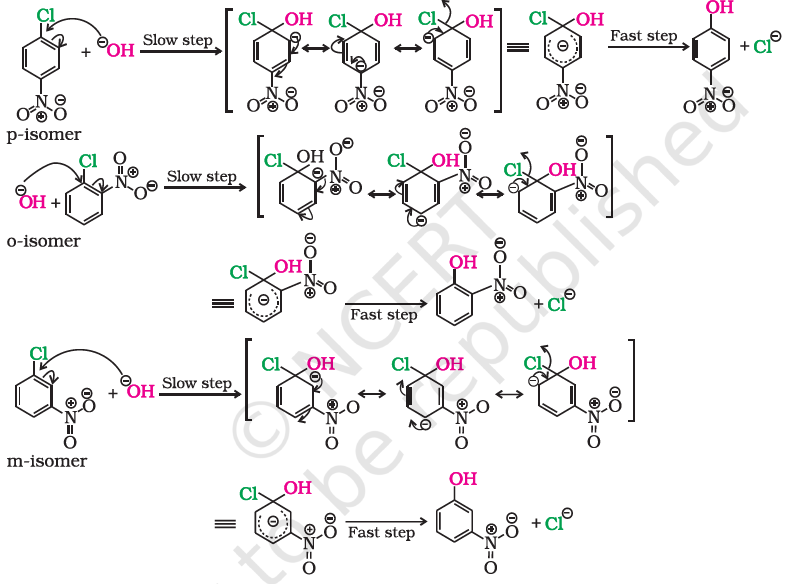
Yahan inn teeno reaction aur inke resonance structures ke basis par agar hum o− aur p−isomer dekhe toh inke case meh jis carbon se electron withdrawing group (−NO2) attach hai uss par negative charge (carbanion) generate hota hai. Ab iss carbanion ko benzene ke π electrons ke sath sath −NO2 group bhi stabilized karta hai.
Lekin agar hum meta-isomer consider kare so iske case meh koi bhi aisa resonating structure generate nahi hota hai jisme electron withdrawing group (−NO2) attached carbon par negative charge generate ho matlab iss case meh carbanion ko sirf benzene ke π electrons hi stabilize karte hai. Iss wajah se carbanion jo o− and p−isomer se generate hua hai wo m−isomer ki respect meh jyada stable hota hai. Accordingly hum yahan kah sakte hai ki jab o− aur p−positions par electron withdrawing group present hote hai tab ye aryl halide compounds ko nucleophilic substitution reactions ke liye activate karte hai. Ab jitne jyada electron withdrawing groups, aryl ring par present hote wo utni hi jyada aryl halide compound ki reactivity increase karte hai.
2) Electrophilic Substitution Reaction
Haloarene compound wahi electrophilic substitution reaction show karte hai jo generally benzene ring show karti hai jaise Halogenation, Nitration, Sulphonation, Friedel Craft reactions. Ab haloarene compound meh halogen atom ek ortho- aur para- directing group ki tarah kaam karta hai so ye compound reaction ke baad hume ortho and para substituted products dete hai. Halogen atom ke ortho- aur para-directing effect ko samjhne ke liye pehle hum iske resonance structures consider kare:
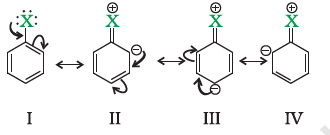
Inke resonance structure (II), (III), (IV) meh hum dekh sakte hai ortho- aur para-positions par negative charge generate hota hai matlab inn positions par electron density relatively jyada hoti hai isliye inn positions par incoming electrophile easily substitute ho sakta hai. Lekin agar hum ortho position ko consider kare toh isme steric hindrance generate hone ki possibility hoti hai, iss wajah se para product generally ortho product par predominate karta hai. Further halogen atom −I effect show karta hai iss wajah se ye electron withdrawing group ki tarah kaam karta hai, as a result ye benzene ring ko deactivate kar deta hai. Iss wajah se chlorobenzene compound ki electrophilic substitution reaction in comparison to benzene slow or drastic conditions meh hoti hai.
Some important reactions of chlorobenzene are given below :
(i) Halogenation : Iss reaction meh haloarene compounds, halogen ke sath in the presence of ferric salt reaction karte hai. For example

(ii) Nitration : Iss reaction meh haloarene compounds, conc. HNO3 aur conc. H2SO4 ke sath reaction karte hai. For example

(iii) Sulphonation : Iss reaction meh haloarene compounds, under heat conc. H2SO4 ke sath reaction karte hai. For example

(iv) Friedel Craft reaction : Iss reaction meh haloarene compounds, alkyl chloride or acyl chloride ke sath in the presence of anhydrous aluminium chloride (catalyst) reaction karte hai tab humari respective friedel craft alkylation aur friedel craft acylation reaction hoti hai. For example
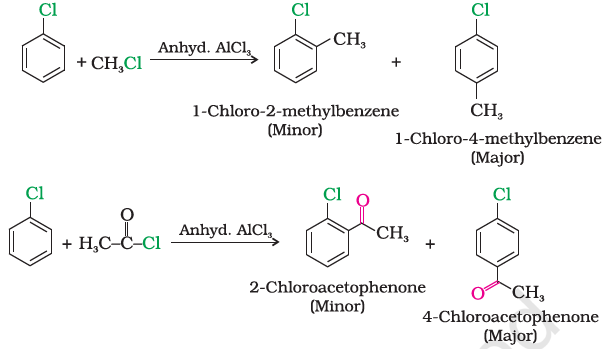
3) Reaction with Metals
(i) Wurtz-Fittig Reaction : Jab alkyl halide aur aryl halide compound ke mixture ko hum sodium metal ke sath in presence of dry ether react karte hai tab ye hume alkylarene compound product deta hai, aur tab iss reaction ko hum Wurtz-Fittig reaction bolte hai. For example

(ii) Fittig Reaction : Jab aryl halide compound ko hum sodium metal ke sath in presence of dry ether react karte hai tab ye hume diphenyl compound product deta hai, aur tab iss reaction ko hum Fittig reaction bolte hai. For example

Chemical Reactions of Haloarenes
Under drastic conditions, aryl halides undergo substitution reactions as discussed below :
1) Nucleophilic Substitution Reactions
Replacement by Hydroxyl Group (formation of phenol) : On heating aryl halides with aqueous solution of sodium hydroxide at 623 K and under pressure (300 atm), the halogen atom is replaced by hydroxyl group forming phenol.

Effect of Substituents in Haloarenes (aryl halides) on the Reactivity :
The presence of certain groups on certain positions of the ring markedly affects the reactivity of haloarenes. It has been observed that the presence of electron withdrawing groups such as −NO2,−CN etc., at o− and p−positions to the halogen atom greatly activates the halogen towards nucleophilic substitution reactions. For example,

It may be noted that nitro group meta to the chlorine has no effect on the reactivity.
Explanation for effect of −NO2 (or EWG), group
The presence of −NO2 groups at ortho and para positions withdraws electron density from the benzene ring and therefore, facilitates the attack of the nucleophile on haloarenes. The carbonion, thus formed is stabilized through resonance as shown below :

It is clear from above structures that in case of o− and p−nitro chlorobenzene, one of the resonating structures in case of p−nitro chlorobenzene and in case of o−nitro chlorobenzene bears a negative charge on the carbon atom bearing the −NO2 group. Therefore, these carbanions are stabilized by the −NO2 group as well as π-electrons of the benzene ring.
However, in case of m−nitrochlorobenzene, none of the resonating structures bear the negative charge on the carbon atom bearing the −NO2 group. Therefore, the nitro group at meta position does not stabilize the negative charge but the carbanion is stabilized only by the π-electrons of the benzene ring. In other words, the carbanions formed from o−nitrochlorobenzene and p−nitrochlorobenzene are more stable than that formed from m−nitrochlorobenzene. Thus, the presence of electron withdrawing groups at o− and p−positions (but not at m−positions) with respect to halogen atom activates the aryl halides towards nucleophilic substitution reaction. Moreover, as the number of electron withdrawing groups at o− and p−position increases, the stabilization of the resulting carbanion increases due to more structures and hence, the reactivity of the aryl halide further increases.
2) Electrophilic Substitution Reaction
Haloarenes undergo electrophilic substitution reactions in the benzene ring. For example Halogenation, Nitration, Sulphonation, Friedel craft reactions. The halogen atom is ortho and para directing and therefore, substitution takes place at ortho and para positions. The ortho and para directing effect of halogen atom can be understood if we consider the resonance structures of halobenzene as shown ahead :

It has been seen that in structures (II), (III) and (IV) the ortho and para positions get negatively charged. In other words, the electron density is relatively more at ortho and para positions and consequently, the incoming electrophile is more likely to attack on these positions. However, because of steric hindrance at the ortho position, the para product usually predominates over the ortho product. Further, it may be noted that the halogen atom has −I effect because it is an electron withdrawing group. As a result, it tends to deactivate the benzene ring. Therefore, the electrophilic substitution reactions of chlorobenzene occur slowly and under drastic conditions compared to benzene.
Some important reactions of chlorobenzene are given below :
(i) Halogenation : It takes place by reacting haloarenes with halogens in the presence of ferric salt as catalyst.

(ii) Nitration : It is carried out by heating haloarene with conc. HNO3, in the presence of conc. H2SO4.

(iii) Sulphonation : It is carried out by heating haloarene with concentrated H2SO4.

(iv) Alkylation and acylation (or alkanoylation) : The reaction, known as Friedel-Crafts reaction, is carried by treating haloarene with alkyl chloride or acyl chloride in the presence of anhydrous aluminium chloride acting as catalyst. For example,

3) Reaction with Metals
(i) Wurtz-Fittig Reaction : When aryl halide is heated with alkyl halide in the presence of sodium in anhydrous ether, halogen atom is replaced by alkyl group and alkylarene compound is formed. This reaction is called Wurtz-Fittig reaction.

(ii) Fittig Reaction : When haloarenes react with sodium in the presence of ether, diphenyl is formed. The reaction is called Fittig reaction.

EXAMPLE 10
Identify X,YandZ in the following reaction
(i) C6H6Cl2/Fe−−−−→XCuCN−−−−→PyridineYHydrolysis−−−−−→Z
(ii) C6H5NH2NaNO2/HCl−−−−−−−→XCuBr−−→YNaOH−−−−−−−−→623K/PressureZ
(i) C6H6Cl2/Fe−−−−→C6H5ClXCuCN−−−−→PyridineC6H5CNYHydrolysis−−−−−→C6H5COOHZ
(ii) C6H5NH2NaNO2/HCl−−−−−−−→C6H5N2ClXCuBr−−→C6H5BrYNaOH−−−−−−−−→623K/PressureC6H5OHZ
SUMMARY
1) The polarity of carbon-halogen bond of alkyl halides is responsible for their nucleophilic substitution, elimination and their reaction with metal atoms to form organometallic compounds.
2) Ambident Nucleophiles : The nucleophiles which have more than one site through which the reaction can occur.
3) The chemical reactions are often accompanied by evolution or absorption of energy.
4) Rearrangement reaction of carbocations formed by diazotization of primary amines leading to the formation of rearranged alcohols is termed as Demjanov rearrangement.
5) The acid-catalyzed rearrangement of vic-diols (1,2-glycols) to aldehydes or ketones is called the pinacol rearrangement.
6) Haloalkanes are one of the most reactive classes of organic compounds. These can be used for the preparation of a large variety of useful organic compounds.
7) In an elimination reaction two atoms or groups (YZ) are removed from the substrate with formation of π bond.
8) Enantiomers : Optical isomers which are non-superimposable mirror images of each other.
9) Haloarenes are chemically less reactive than haloalkanes.
10) Racemic Mixture : An equimolar mixture of enantiomers (dextro and laevo forms).
11) Racemisation : The process of converting d− or l− forms of an optically active compound into racemic form (dl).

